

Posts Filtered by Type - Blog |
Show Recent Posts
December 14, 2024
In Memory of Gene Scharle
In Memory of Gene Scharle
Long-time Honorary Club Member Gene Scharle passed away on May 15th.

Gene made significant contributions to the club, serving as Club President in 1998, 1999, and 2010, as well as Vice President in 1983, 1984, 1985, 1992, and 1999, and Treasurer in 1987 and 1988. He also held the position of Publicity Chair and managed our Post Office Box. Gene played a crucial role in the creation of the D & L Trail. He was always eager to volunteer and educate others about the hiking club and outdoor activities. Gene enjoyed hiking, backpacking, camping, bike riding, and spelunking.
A couple of the hikes that Gene lead were the Seven Tubs Hike and his annual tubing down the Lehigh River event. Gene had a dry sense of humor and he will be deeply missed.

December 14, 2024
In Memory of Bernie Harris
In Memory of Bernie Harris
Former AHC President Bernard (Bernie) Harris died July 24 in Greenup, Illinois, while traveling with his family.
He was one month shy of his 90th birthday. Bernie served as AHC vice president in 2005-2007 and as president in 2008. He declined reelection because he and wife Edna were moving to central Pennsylvania to be near their grandchildren. Bernie was an avid hiker and hike leader. When AHC needed to find a new meeting location in 2007, Bernie located a home for AHC at St. Timothy Lutheran Church.

A breakfast gathering at the ATC Biennial Meeting in Maine in 2017. In the foreground are Bernie and Edna Harris, with Ginny Musser and Holly Vogler.

December 14, 2024
AHC and the D & L Trail: 25 Years of Commitment
AHC and the D & L Trail: 25 Years of Commitment
In July, 1999, Sherry Petrilak and Tom Gittings of the Wildlands Conservancy attended the AHC monthly meeting to talk about a new trail, the D & L Trail, and recruit volunteers to be Trail Tenders to help maintain and improve the trail. This simple encounter has led to a 25-year continuing partnership between our two organizations.

AHC decided to become a roaming maintaining group, tackling areas that needed attention. Gene Scharle served as liaison with the Delaware and Lehigh National Heritage Corridor and organized club participation in work trips. The first outing was Nov. 20 to Lock 22 at Mud Run, 2.7 miles north of Rock-port. The club improved an access trail from the D & L to the lock and removed vegetation from the lock.
During the span of 10 years, AHC participated in 30 work days. Club members volunteered at Lock 2 south of Glen Onoko, Lock 4 north of Glen Onoko, Lock 22 at Mud Run, Lock 24 near Lehigh Tannery, Locks 28 and 29 near White Haven, and Dam 4. As a change of pace, AHC tackled clearing vegetation from the railroad turntable south of Glen Onoko, and built an access trail with a rail fence. The club also performed trail maintenance at the Penn Haven Plane, Weissport, Parryville, and spent a day upgrading signage and kiosks along the trail. At most of these events, the Delaware and Lehigh National Heritage Corridor provided lunch to the volunteers.
After 10 years, in 2009, AHC decided to adopt Lock 2 south of Glen Onoko. Built 1836-1838, Lock 2 is a 17 foot high lift lock, 22 feet wide and 125 feet long, with a buttress extension on the river side of the lock. Carl Griffin and Jim Gabovitz assumed responsibility for planning the twice a year work trips and directing club volunteers. Our volunteers have cleared vegetations from the capstones, inside the lock, and between the lock and the river so that rafters can see the lock; built a set of steps to facilitate visitor access to the inside of the lock; planted grass inside the lock;, dug out the headwall; removed graffiti and invasive plants; and erect-ed two signs. The club also maintains the three-tenths mile access trail from the D & L Trail at the railroad trestle to the lock. Lock 2 is in good condition.
Although AHC has not formally adopted the Coalport Guard Lock, which is just over a half mile south of Lock 2, the club has also worked at this lock and maintains the access trail between the two locks. This lock is also well preserved, although an earthen dam has been created across the center of the lock.

October 7, 2024
Fall Hiking, Corridor Monitoring, End of Year Activities
by Paula Urhin
Fall Hiking, Corridor Monitoring, End of Year Activities
by Paula Urhin
Hunting season is already upon us in Pennsylvania and this is a good time to prepare before venturing outdoors.

Photo: Ice Age Trail Alliance
Specific dates for hunting seasons from vary year to year. Before you go, learn the regulations and hunting seasons for the areas where you will be hiking. Note that the Pennsylvania Game Commission announced three Sunday hunting dates for 2024: November 17, 24, and December 1. For more details on the hunting seasons in Pennsylvania you can reference the Pennsylvania Game Commission website.
Be sure to wear a brightly colored clothing. Colors such as blaze orange or neon green or yellow are recommended. Basically, the brighter the better. (Orange safety vests and hats from Walmart work fine and are inexpensive.) On State Game Lands in Pennsylvania, all hunters and non-hunters are required to wear a minimum 250 square inches of daylight fluorescent orange material on the head, chest and back combined and it must be visible from 360 degrees. An orange hat and vest satisfies this requirement. Many hiking paths including parts of the Appalachian Trail use state game lands, and even if you are not hiking on State Game Lands it is a good practice to adopt during hunting season. If you hike with a pet, it should also wear a blaze orange vest, collar, leash or bandana so it is visible from all sides. The AT recommends that pets be leashed at all times while hiking.
Avoid wearing colors that could be mistaken for game animals. Avoid any brown, tan, earth tones and especially white - you do not want to look like the flash of deer's tail. During turkey season avoid red, blue, purple, black and white. These are the head colors of a male wild turkey. Use extra caution particularly at dawn and dusk. Hunting activity typically increases during those times as that is when animals are feeding and visibility is poor. Hike during broad daylight when hunters can more easily identify you. Be especially cautious close to road crossings, trailheads, and in valley areas. Utilizing a flashlight or headlamp will help with visibility and identify you as a human and not a critter. Avoid the most popular hunting days, like opening weekend. In Pennsylvania that would be the Sunday after Thanksgiving and extending into the first two weekends of December. When you do go, choose trails that are off-limits to or unpopular with hunters. In this area there are several preserves that do not participate in hunting activities. Stick to established, marked trails. Skip the bushwhacking during hunting season as hunters are more likely to expect hikers on trails.
This is also the time of year that the Club performs our annual Corridor Monitoring. Basically we don't hike the Appalachian Trail (AT) itself but the boundaries that parallel it to ensure that there is no encroachment or other activities occurring that would endanger the AT. If you are interested in helping with the monitoring or just want to go along and find out what is involved, keep your eye on the forum (the AHC’s emails) or contact Lucy Cantwell. Additional information regarding Corridor Monitoring can be found on the Appalachian Trail Conservancy’s (ATC’s) website.
Lastly, there are lots of events on our third quarter calendar and that includes some of my favorites. December starts out with our Annual Holiday Feast, a pot luck where club members bring in their favorite dishes to share, both sweet and savory ... and I always say that hikers know how to eat and also how to cook, so there are always lots of great treats to try. If you have never attended an Allentown Hiking Club meeting, this is a good one to attend. There are also Holiday-related events such as a walk through the Allentown Lights in the Parkway and a Bethlehem Holiday Hike ... both festive ways to get outdoors. Finally, close out the year with our Annual New Year’s Eve Hike to the Allentown Shelter, with two distance options. This event has been taking place since 1976 and is a great way to close out a year of hiking while sharing good fellowship with other hikers. I hope to see you on one of these fun events!
Happy Fall and Happy Trails!
Paula Uhrin
President, Allentown Hiking Club
President, Allentown Hiking Club

October 4, 2024
Hurricane Helene and the Appalachian Trail
by Hal Wright
Hurricane Helene and the Appalachian Trail
by Hal Wright
The magnitude and scope of tragedy in the aftermath of Hurricane Helene continues to unfold.

Damage to Bluff Mountain Outfitters in Hot Springs, NC, as documented on the The Trek's Instagram account. The author obtained gear and shuttle rides from this merchant while completing the AT in Tennessee and North Carolina.
Pearisburg and Damascus, VA. Erwin, TN. Asheville and Hot Springs, NC. These are just some of the iconic towns along the southern Appalachian Trail decimated by Hurricane Helene.
Those of us who have completed the southern AT have visited all of these towns and enjoyed the hospitality of their residents. Our hearts break with the realization of what they have lost. You may be inclined to help with a donation and even volunteer work. We at Allentown Hiking Club are not positioned to offer advice on the best charities and organizations to pick; we urge you to research options carefully. We can direct you to the Appalachian Trail Conservancy's webpage which describes the damage and links to reputable aid organizations.
We also urge you to monitor what the Appalachian Trail Conservancy has to say about trail access and use. Within the hiker community, there is often skepticism about the ATC's guidance during emergencies. Concerns include the loss of income to shuttle drivers and hostels when the ATC closes portions of the trail. And hikers tend to march (hike) to their own drummer; part of the appeal of the AT is that it stands apart from the restrictions of ordinary life. Given these unique circumstances though—that resources are strained along the southern AT, that the priority must be to restore housing and services to permanent residents, and that the ATC must follow direction from its land managers such as the Forest Service—we recommend that hikers heed the ATC's closures and stay off the trail where indicated. Note that the ATC has altered its normal rules for acknowledging thru hikes. Here is their webpage which summarizes guidance to hikers.
Finally, as climate change makes storms such as Helene more likely, it's worth noting that the ATC has been studying the impact of climate change on the Trail and its surroundings for decades. We are reminded of the expertise the ATC brings to stewardship along the Trail we love.

October 3, 2024
Tragedy on the AT: A Rare Cautionary Trail
by Hal Wright
Tragedy on the AT: A Rare Cautionary Trail
by Hal Wright
The death of a 67-year-old thru hiker in Virginia reminds us to keep track of our health before and during long distance hikes.

A screenshot of the Appalachian Trail Conservancy's page on hiker safety
Tragic incidents on the Appalachian Trail are rare indeed. Over three million people set foot on the A.T. every year. Thousands of these visitors hike the entire trail or large sections of it. While few of these hikers experience serious health-related issues, we've learned of the recent death of 67-year-old thru hiker Thomas VanEtten, apparently of natural causes, along the trail in Virginia. VanEtten's obituary states that completing a thru hike of the Appalachian Trail was "something he had wanted to do for years." We can at least take solace in the knowledge that VanEtten passed on doing something he loved.
The Appalachian Trail Conservancy offers much advice for staying safe while hiking a long-distance trail. Equally important is having an awareness of one's health before starting to hike. For older hikers, an assessment of one's heart health and general fitness is especially important, given that the rigors of a long-distance hike are difficult to replicate in life off the trail. Also, it's important to plan a hike which respects one's limitations in terms of miles walked per day, pack weight, and terrain. Better to be prepared to hike 10 miles per day and to experience the delight of learning that it's possible to hike farther, than it is to extend a hike for one or more days without the food needed to stay on the trail.
Contrary to some comments of some younger hikers on social media, hiking in one's 60's and beyond is not too dangerous to attempt. If that were true, many of us in Allentown Hiking Club would have been off trail for a long while!

July 14, 2024
Volunteerism
by Paula Uhrin
Volunteerism
by Paula Uhrin
The Allentown Hiking Club could not do all it does without the assistance of a multitude of volunteers.
Big tasks, small tasks, and everything in between ... everything we do is because of our volunteers. If you already lend your time to our efforts ... THANK YOU! If you haven’t yet gotten involved ... there’s no time like the present! The Club has administrative needs, trail needs, liaison needs, you name it. There are so many ways to get involved to help make the Club successful, active, and vibrant.
We work closely with the Appalachian Trail Conservancy as one of the 30 trail clubs that maintain the entire 2,190+ miles of the Appalachian Trail. We maintain trails within the nearby Lehigh Gap Nature Center. We support organizations such as the Keystone Trails Association. We liaise with nearby trails clubs such as the Blue Mountain Eagle Climbing Club. We coordinate with AT land managing agencies such as the Pennsylvania Game Commission. Many of these organizations also rely heavily on their own volunteers. We offer multiple hikes of varied skill levels each month to allow members to enjoy the outdoors and explore new environments. We maintain trails, support conservation, and simply gather to enjoy the outdoors, and all of that takes volunteers to make it happen. And as I often say ... many hands make light work. The more people get involved, the easier it becomes and the lighter the load for all.
If you’re looking for ways to get more involved, reach out to me or any of the Club leaders, or better yet attend one of the monthly Club meetings. Even if you only have a few hours each month, that helps to make a big difference. The success of our Club depends on our membership and its leaders. No task or activity is too small and every little bit helps.

July 14, 2024
Harold L. Croxton, 1920-2024
Harold L. Croxton, 1920-2024
AHC Honorary Member Harold L. Croxton died March 10, 2024, at age 103, in Spokane, WA.

Harold joined AHC in 1967 and immediately became an active member. The citation for his 1985 Honorary Member award listed his contributions as hike leader, trail worker, Trails Chair, Keystone Trails Association Monitor Coordinator, and member of the AT Corridor Management Committee. During his tenure as Trails Chair, in 1978 a trail was cut to the Yellow Spring near the Allentown Shelter, and Harold organized yearly schedules of weekend shelter caretakers for the Allentown Shelter. Under Harold’s guidance as Corridor Monitor Chair, the club began its corridor boundary monitoring and annual reporting. Harold oversaw the installation of the gate and boulders at Fort Franklin Rd. to prevent illegal vehicle access to the AT. In 1993, Harold received the Silver Volunteer award at the Appalachian Trail Conservancy Biennial, and in 2001 he was honored with an Appalachian Trail National Scenic Trail Golden Service Award. Harold was also an Appalachian Trail 2000 miler, completing the trail in 1976.
Harold was born in Illinois, graduated from the University of Illinois in 1942, and was hired by the Accounting Department of Bethlehem Steel Corporation. He served in the US Navy during World War II and then returned to work at Bethlehem Steel until his retirement. He married Rosemere in 1947 and they were married 75 years when she died on Aug. 29, 2022 (Harold’s 102nd birthday). Harold and Rosemere were avid hikers and world travelers, visiting 42 countries on six continents, backpacking through the Swiss Alps, and climbing Mt. Kilimanjaro to the 15,000 foot level.
As a member of the Allentown Hiking Club, Harold volunteered to do whatever was needed, and he and Rosie were always willing to assist other club members in reaching their hiking goals. They were shining examples for club members to emulate.

July 14, 2024
Bear Box Installed at G. W. Outerbridge Shelter
Bear Box Installed at G. W. Outerbridge Shelter
On May 9th members of the Allentown Hiking Club worked alongside those from the Keystone Trails Association, Appalachian Trail Conservancy, the National Park Service and PA Outdoor Corps to install a bear box near the George W. Outerbridge Shelter on the Appalachian Trail.
The large and heavy bear box was moved by hand up the mountain to the shelter area.


The bear box was placed near the shelter.

The crew...


March 4, 2024
A Look Back and a Look Ahead
by Paula Uhrin
A Look Back and a Look Ahead
by Paula Uhrin
Looking back to our hikes throughout the year I’m excited to remember all the places we’ve been and energized about what hikes are yet to come in 2024.
Throughout the year we had hikes on the rugged and rocky Appalachian Trail, treks on city streets, maintenance activities to keep our trails clear and passable, and everything in between. Hike leaders continually gather like minded individuals to take them on a journey, in some cases to places they have not yet visited. And whether it’s a familiar trail or something new, it’s always fun to explore new places with folks who share the same appreciation of the outdoors. That’s what the Allentown Hiking Club is all about.
Enjoy these snippets from our year in hiking/trekking and keep watching the club calendar for upcoming activities. If there are hikes you would like to lead and share with others, please reach out or, better yet, come to a monthly meeting and the Club will help and support you throughout that process.
And I could not conclude the year without expressing a heartfelt thank you to Ed Ritter who recently stepped down as the Club 's Trails Chair. His support throughout the decades has been invaluable. I also want to say a big thank you to Kerry Snyder fo r stepping up to assume the responsibilities of Trails Chair. I know our club's maintenance activities will continue to be in very good hands. And an additional thank you goes out to Cyril Quatrone who has stepped up to take on the role of Programs Chair. We can look forward to presentations at our monthly meetings in the upcoming months. If you have ideas for a program please reach o ut to Cyril.
Happy New Year to all and Happy Trails!











March 4, 2024
Post Cards from Thru Hikers
Post Cards from Thru Hikers
Our club received two postcards from thru hikers thanking us for our maintenance efforts.




January 23, 2024
Maintenance Hike Garners Eleven Volunteers on 24 Hours Notice
by Hal Wright
Maintenance Hike Garners Eleven Volunteers on 24 Hours Notice
by Hal Wright
Trails Coordinator Kerry Snyder called for volunteers to help clear blowdown from the trail. On less than 24-hours notice, eleven volunteers responded.

This maintenance hike was arranged after Kerry received reports of a large amount of blowdown blocking the AT between Route 309 and Knife's Edge, a little over three miles north on the trail. The crew included AHC members and Alison ("Double H"), a 2023 thru-hiker who was in central PA for a family visit from her home in New Hampshire. The blowdown blocking the trail ranged from mere branches to numerous large trees. Kerry, the certified sawyer in the group, donned safety gear and did all of the chainsaw work.
Outing such as this exemplify the commitment of our volunteers and thousands more up and down the trail to provide the best possible experience for Appalachian Trail hikers.
We've created a gallery of photos taken during this maintenance hike which you may view here.

October 30, 2023
Mary Ann, My Hiking Inspiration
by Paula Uhrin
Mary Ann, My Hiking Inspiration
by Paula Uhrin
Surrounded by fellow club members and hiking enthusiasts, long-time Allentown Hiking Club member Mary Ann Nissley recently celebrated a milestone birthday on the Appalachian Trail by hiking the Pinnacle and Pulpit loop.

Mary Ann started hiking later in life but started with gusto! Never having hiked a step previously, she reached out to the Appalachian Trail Conference (now Conservancy) to understand where to begin. It was suggested that she reach out to and join a local trail club and the rest, as they say, is history ... hiking history, that is. Mary Ann went on to hike the full length of the Appalachian Trail twice, once as a thru hiker and once as a section hiker. She has also completed a long list of other trails throughout the country; the list is several pages long!
I first really spoke with Mary Ann about ten years ago, shortly after she hiked the Pulpit and Pinnacle loop with her family in celebration of her 80th birthday. I was so in awe. After all, I had only just started hiking and knew that trek was quite the challenge. But she seemed unfazed and proudly told me that she would be making the same trek in ten years for her 90th birthday. I think from that moment forward I have always told her that I want to be like her when I grew up ... and that’s true even more today.
The day of the hike we could not have asked for more perfect weather, warm but not too warm and with minimal humidity. Mary Ann arrived at the hike start having already completed her 6 mile bike ride for the day. She was smiling from ear to ear and was ready to go! She was joined by 21 hikers, mostly club members but some who wanted to come along because they saw her on a segment on WFMZ News the day before. We couldn’t let the occasion pass without cake and before we started hiking there was cake with candles and a Happy Birthday banner. Everyone there joined in singing "Happy Birthday" and shared in the cake to help power us up the mountain. And then we were off...
Slow but steady we trekked up the almost 1000’ elevation gain to the Pinnacle, one of the most beautiful vistas on the Appalachian Trail, stopping only to drink some water or admire the flowing waters of Furnace Creek and an abundance of mushrooms along the way. And then before we knew it that big pile of rocks was in sight (if you know, you know). The Pinnacle was just ahead. Mary Ann picked up a rock and tossed it to add to the pile, a long-standing tradition, and then settled in for a snack and a surprise birthday cupcake. She truly was beaming with happiness that the club helped to make her birthday trek happen. There were lots of pictures taken up at the top. Mary Ann was a celebrity, after all, with an entourage, and everyone wanted their picture taken with her.

After another slow and steady trek back down the mountain, with Mary Ann "putting on the brakes" in the steeper spots, we made it back down to the Hamburg Reservoir and then the starting parking lot. Along the way we told every other hiker we saw about this milestone birthday and made sure Mary Ann got lots of Birthday wishes throughout the day ... and with the beautiful weather there were several dozen people out on trail that day so there were a lot of well wishes! Honestly, my face was sore at the end of the day after smiling so much, watching Mary Ann enjoy her day doing what she so loves to do.

They say age is just a number and I believe that even more now. I wouldn’t doubt we will be making this same trek in ten years for Mary Ann’s 100th birthday ... I truly would expect nothing less. And it just goes to show that hiking is indeed just one foot in front of the other, over and over, until you reach your goal. If this doesn’t give everyone the needed inspiration to get to on trail, I don’t know what does.
Happy Trails!



October 4, 2023
Club Member Completes the Appalachian Trail
Club Member Completes the Appalachian Trail
Club member Hal Wright ("A.T. Pokey") has finished the Appalachian Trail after 25 years of section hiking.
Having started in the late 1990's by hiking outward from Pennsylvania in both directions, Hal's last hike was on the northernmost 115 miles of trail, the Hundred Mile Wilderness and Baxter State Park in Maine. The weather during his summit of Katahdin was perfect - 70's and clear with low winds - after downpours aplenty in the Hundred Mile Wilderness.
Hal thanks the many people who offered inspiration and practical assistance, especially Judy ("Peanut"): his wife, hiking partner for over 300 miles, and support person for every section from beginning to end. This journey would not have happened without family, friends, the hiker community, and of course the staff and volunteers of the ATC and the other organizations which support the trail. It is a team effort and a team accomplishment!

"I made it!" The standard celebratory photo at Baxter Peak, Katahdin, the northern terminus of the Appalachian Trail. Elevation: 5267 feet.

The view down from the Gateway on Hunt Spur, Katahdin. Climbing Katahdin on the A.T. involves a steep rock scramble here with near 360° exposure.

Table Land, a flat section with alpine vegetation reached after scaling the Katahdin massif. Baxter Peak can be seen in the background, still almost two miles away.

The return trip was made on the Abol Stream Trail, which drops straight down from the Table Lands on a rock slide.

This from one of Hal's first hikes in Pennsylvania in the late 1990s.

August 24, 2023
Help Wanted
Help Wanted
Our Club relies solely and heavily on volunteers to fulfill our mission.
The Allentown Hiking Club was established in 1931. As our bylaws state, the aspiration of this club is to escape the crowded city; to walk, hike and climb for enjoyment and exercise with nature loving companions; to maintain its section of the Appalachian Trail; and to stimulate public interests in every phase of nature and the outdoors through programs and lectures.
At this time there are three positions within the Club that are in need of energetic individuals to pick up and carry the torch.
Membership Secretary
The Membership Secretary is often the first point of contact that prospective members have with the Club. This individual will answer questions about Club membership and events to help members understand requirements and expectations. They will maintain the online database of Club members, collect and deposit dues into the Club's bank account, and report out statistics at monthly Club meetings. In addition, Club merchandise such as T-shirts, patches, and stickers, will be stocked and sold as needed.
Programs Committee Chair
The Programs Committee Chair will schedule the presentations provided at the Club's monthly meetings. Typically each quarter there are two meetings that offer an opportunity for a presentation on a topic pertinent to Club activities and interests. The individual will identify opportunities and take suggestions from Club members and follow up with prospective presenters to determine an agreed upon date for the presentation and ensure the presenter has all the information required to make a successful presentation and event.
Trail Maintenance Chair
The Trail Maintenance Chair works to ensure that the Club's section of Appalachian Trail remains open for all. In general, responsibilities will include: Perform and/or coordinate the general maintenance of the AHC's section of the AT. Promptly coordinate the reporting of any significant damage, erosion, large trees down etc. Monitor and repair the Club's two shelters, one privy, and any campsites. Coordinate the Club's annual maintenance hike and picnic. Establish and maintain appropriate storage for Club tools and supplies. Establish maintain connections with locally designated A. T. Communities. Coordinate and/or serve as a volunteer manager.
If you are interested in any of these positions or simply would like additional information, please do not hesitate to reach out to me or the individuals currently in these roles. As I always say... many hands make light work... and with everyone's help we can continue to thrive as an AT maintaining club and serve the trails well into the future.
Happy Trails!
Paula Uhrin
President, Allentown Hiking Club

July 28, 2023
A Great Washington Post Article on AT Relocations
A Great Washington Post Article on AT Relocations
Featuring an animated map and folks many of us know (Bob Sickley and Hawk Metheny, among others), the article describes in engaging detail a few notable AT relocations culled from thousands since the inception of the trail.

A screenshot from the article from the section that describes relocations along Kittatinny Ridge near Palmerton.
I wish Dan Kunkle had been mentioned in relation to the re-greening and trail relo near Palmerton. But I cannot blame the reporter for that omission; Dan's outsized role in getting the ball rolling on that project is not described on the Lehigh Gap Nature Center website.
This article is a reminder that we are playing a role in the evolution of the Appalachian Trail with every work and maintenance trip, and that such work matters to millions of people.

May 13, 2023
Thru Hikers to Reach PA Soon
Thru Hikers to Reach PA Soon
It's almost that time ... time for thru hikers to make their way through our section of the Appalachian Trail

Thru-hikers enjoying some AHC hospitality in 2022.
Many thru hikers vary their route, starting their treks at different times and locations, and therefore could be making their journey any time of the year. But more than one thousand traditional NOBO (northbound) thru hikers have already begun their journey at the AT's southern terminus, Springer Mountain in Georgia, and are making their way towards its northern terminus, Mount Katahdin in Maine, roughly 2,190 miles later.
Anywhere from May through July many of those hikers will pass through our 10.3 mile section on their roughly 6 month trek.I alwavs find it interesting to spend a few minutes talking with thru hikers who are willing to chat, asking where they're from and why they've chosen to hike the AT. I have met hikers from all over the world and am always amazed that people are drawn to come here, into essentially our back yard, to fulfill what is often a lifelong dream.
And as for reasons to hike the AT, there are likely as many reasons as there are hikers, and each person's story is unique and often inspiring.It's easy to wonder what can be done to offer help or assistance. Any act of kindness is appreciated and even small gestures can make a significant impact. When on trail, these acts of kindness are referred to as trail magic... finding just what you need right when you least expect it and random acts of generosity.
If you're hiking on the AT, perhaps carry some extra food or water. That little bit can help a hiker make it to their next resupply stop, or even just to the next water source. A first aid kit is useful and can get someone cleaned up or patched up so they can more comfortably continue on their way. Even taking their trash can help to lighten their packs and improve their onward journey.
Some things to keep in mind are to not leave any food or drink unattended, keep the gestures small, and Leave No Trace.The Allentown Hiking Club organizes two days of Trail Magic hiker feeds' at the end of June to feed and water any and all thru and section hikers that pass by. Some hikers stay only a few minutes to refill their water reservoirs and bellies, and some stay for hours partaking of interesting conversations with club members and other hikers. I think it's safe to say that everyone ends the day feeling better about humanity. Watch the club calendar for dates and further details so you, too, can experience this opportunity for yourself.Happy Trails!

May 11, 2023
Update: Essential Trail Maintenance Workshop with the Appalachian Trail Conservancy
Update: Essential Trail Maintenance Workshop with the Appalachian Trail Conservancy
In 2022, the Allentown Hiking Club, in conjunction with the Appalachian Trail Conservancy, offered full-day workshops to review and teach trail maintenance standards to those eager to get involved and help maintain the Appalachian Trail. We are keeping an eye out for such opportunities in 2023 and beyond.

There are a variety of ways to get involved with the Trail and one fun way is to help with trail maintenance. Essential trail maintenance helps protect natural resources and improves the hiking experience. After grasping the basics, participants were better prepared to join future work trips with the AHC and ATC, and possibly adopt their own section of the Trail to maintain. Attendees gained valuable skills and conservation experience, benefited from a light workout, and got some quality time outside as they made the Appalachian Trail (AT) a better place.
With almost 2,200 miles of Trail spanning across the east coast from Maine to Georgia, the AT provides a place of sanctuary from the bustle of the modern-day world for both human and wildlife communities alike. Since its inception as the first National Scenic Trail 100 years ago, the A.T. has always depended on volunteers - people like you who are willing to contribute their time, interest, and skills in order to make it all possible. This training workshop introduced new and experienced participants to modern maintenance practices for use on the Appalachian National Scenic Trail. With a focus on safety, the course included topics covering: Trail Condition Assessment, Dealing with Water Issues, Brushing, Keeping Hikers on the Centerline, and Marking the Trail.
If you could not attend this year, keep an eye on our club calendar for next year or visit the AT's events page for additional opportunities: https://appalachiantrail.org/events/.

February 13, 2023
Corridor Monitoring - A Photo Gallery
Corridor Monitoring - A Photo Gallery
The Appalachian Trail is a 2200 mile footpath from Georgia to Maine. But what makes it a path worth walking is the protection of land along the Trail where it does not already pass thru national parks or lands protected by the states. Based on legislation passed in the 60's and 70's, the National Park Service acquired land rights to over 100,000 acres of land along the Trail. This "corridor" is maintained by the Appalachian Trail Conservancy and member Trail clubs, including AllentownHikingClub.org.
Recently, on the second day of black bear season, with wind chills in the teens, and accompanied by Paula Uhrin, I did my first stint as Corridor Monitor for NPS segment 338 along the AT. Nonetheless, ours was a very successful outing! We located all the monuments marking the boundary with private land and saw no signs of encroachment.






February 1, 2023
The Allentown Hiking Club ... this is OUR Club
by Paula Uhrin
The Allentown Hiking Club ... this is OUR Club
by Paula Uhrin
As we are about to embark into a New Year, I'm once again reminded that everything the Allentown Hiking Club does is for and because of its members. Members continue to be what makes the Allentown Hiking Club thrive, and that includes new and long time members with both new and tried and true hikes and ideas. It is that combination of old and new that helps the club draw from past experiences to further our goals and mission.
I want to make the time for a few introductions and thank yous.
I first want to thankoutgoing Treasurer Michelle Hinkle for all of her time and support over the past six years in that role. While having been a club member for some time, Michele stepped up when the opportunity arose and her support has always been greatly appreciated. I want to welcome Liz Uhl into the position of Treasurer and thank her for similarly stepping up when additional support was needed. I look forward to her input and support in the future.
Along those lines, I couldn't help but notice the ever presence of our Secretary Dick Fink, who has been dutifully fulfilling his responsibilities for the past 18 years. I can hardly recall a time that his soft spoken leadership wasn't there to keep the club on track and I want to thank him for his continued support.
And finally, Karen Gradel has been serving in both President and Vice President roles for the past ten years. Her ongoing leadership and overall support in those roles and others has shaped the club into what it is today.
I simply cannot imagine where the Allentown Hiking Club would be without the support and guidance of these individuals. All the said, there are always opportunities to get more involved and help to shape our future. In the new year I encourage members to find new ways to support the club, with nothing being too small of a gesture. If there is a hike or walk you enjoy and think others would enjoy it, then add it to the club calendar. If there is a role within the club you think you may be interested in, then reach out for more information. If you're unclear what roles and opportunities are even out there, I'm happy to have that conversation. If you've recently made a trek that you would like to share with the club, let us know and you can present at at upcoming meeting. Plus there are always ongoing trail maintenance opportunities, our annual Trail Magic in June, snacks for monthly meetings, and countless other activities that keep us going throughout the year. Again, no support is too small or insignificant. Thank you all for another great year on trail, hiking and maintaining and sharing the magic.

October 1, 2022
Hiking During Hunting Season
by Paula Uhrin
Hiking During Hunting Season
by Paula Uhrin
Hunting season is upon us in Pennsylvania and this is a good time to prepare before venturing outdoors.

Specific dates for hunting seasons from vary year to year. Before you go, learn the regulations and hunting seasons for the areas where you will be hiking. Note that the Pennsylvania Game Commission announced three Sunday hunting dates for 2022:
November 13, 20, and 27. For more details on the hunting seasons in Pennsylvania you can reference the Pennsylvania Game Commission website (https://www.pgc.pa.gov).
Be sure to wear a brightly colored clothing. Colors such as blaze orange or neon green or yellow are recommended. (Orange safety vests and hats from Walmart work fine and are inexpensive.) Clothing should include a hat and vest (and pack cover or large bandana), or hooded outerwear that can be seen from all angles when hiking during hunting season. On state game lands in Pennsylvania, all hunters and non-hunters are required to wear at least 250 square inches of fluorescent orange material on the head, chest and back combined, or a fluorescent orange hat, from Nov. 15-Dec.15 (except on Sundays with no hunting). The orange material must be visible from all angles (360 degrees). Many hiking paths including parts of the Appalachian Trail use state game lands, and even if you are not hiking on state game lands it is a good practice to adopt during hunting season. If you hike with a pet, it should also wear a blaze orange vest, collar, leash or bandana so it is visible from all sides. The AT recommends that pets be leashed at all times while hiking.
Avoid wearing colors that could be mistaken for game animals. Avoid any brown, tan, earth tones and especially white - you do not want to look like the flash of deer's tail. During turkey season avoid red, blue, purple, black and white. These are the head colors of a male wild turkey. Basically, the brighter the better!
Use extra caution particularly at dawn and dusk. Hunting activity typically increases during those times as that is when animals are feeding and visibility is poor. Hike during broad daylight when hunters can more easily identify you. Be especially cautious close to road crossings, trailheads, and in valley areas. Utilizing a flashlight or headlamp will help with visibility and identify you as a human and not a critter.
Avoid the most popular hunting days, like opening weekend. In Pennsylvania that would be the Sunday after Thanksgiving and extending into the first two weekends of December. When you do go, choose trails that are off-limits to or unpopular with hunters. In this area there are several preserves that do not participate in hunting activities. Stick to established, marked trails. Skip the bushwhacking during hunting season as hunters are more likely to expect hikers on trails.
Enjoy the trails and stay safe out there!
Paula Uhrin
President, Allentown Hiking Club
President, Allentown Hiking Club

August 22, 2022
Bake Oven Knob Grafitti Cleanup
Bake Oven Knob Grafitti Cleanup
Photos of the 2022 clean-up of graffiti at Bake Oven Knob give a sense of the scale of the effort and the cooperation required between agencies.

Before and after the clean-up

Fire crews pump water to the Knob

Drying the hoses before re-rolling them
Learn more about the ongoing effort to keep Bake Oven Knob graffiti-free here.

August 21, 2022
Summer Hiking
by Paula Uhrin
Summer Hiking
by Paula Uhrin
Every season brings with it unique hiking challenges. While long summer days offer lots of time to play in the outdoors, the accompanying heat can pose a challenge even for the most seasoned of hikers. I find hiking in warmer weather to be the most challenging and have developed ways to make my summer treks more enjoyable and safe.
It all starts with planning... where, when, and how far? Choose a hike that suits the conditions. Hikes under a canopy of leaves can provide shade and a more pleasant experience than a trek out in the open. A winter traipse in warming sunshine is a completely different experience than the same slog done in the summer, baking in the full sun all day. Trails with stream crossings, which could pose a challenge when frozen in the winter, can offer an opportunity to take a rest and chill your feet. Perhaps instead of one lunch stop make more frequent stops along the way to refuel and hydrate and allow your body to cool down. Hiking during mornings and evenings can help to avoid the hottest part of the day. And while taking on a long and challenging trek may sound exciting, shorter hikes may be the way to go when the temperatures soar.
What to bring? Water/liquids and fuel are critical. Whatever your drink of choice, having sufficient fluids with you will help to ensure you stay hydrated. Consider keeping a thermos of ice water or electrolyte beverage in your car so you know it’s available to drink after your hike is complete. You or your hiking companions could be very glad it’s there. Calorie requirements can be very different depending on the time of year you hike. Be sure to have enough food with you to carry you throughout the trek, and having an additional snack with that thermos of water in your car could be good idea, too. Salt tablets and electrolyte chews can help to boost your energy mid-trek and are lightweight and easy to carry and have on hand.
Gear can be a very personal choice ... poles, no poles, large pack, small pack, boots, trail runners, all likes of clothing and layering options ... be sure that the gear you have is suitable for the hike you’re about to do. I often say I’d rather have it and not need it than need it and not have it. Carrying that extra piece of gear could be the difference between and enjoyable journey and one that you would prefer to not repeat. Loose and breathable clothing in light colors and wicking fabrics will help you stay more comfortable in warm weather. First aid kits, headlamps, sunscreen, hats, bandanas, sunglasses ... the list goes on. Be sure what you have with you is fitting for the task and trek at hand.
This is certainly not an exhaustive list but some thoughts and ideas I’ve found to be helpful over the years. Where ever you choose to hike, please stay safe out there!

August 21, 2022
Barb Wiemann Receives 50 Year Service Award
Barb Wiemann Receives 50 Year Service Award
Barb has been a member of the club since 1971 and became an Honorary Life Member in 2002. Here is a list of Barb’s contributions to the Club and ATC.

Allentown Hiking Club
- Served as Secretary in 1974, Librarian 1997-1999, President 2000-2002, and archivist/historian 2000-present
- Corridor Monitor Chair 2005-2015, and corridor monitor
- Hike leader for AT hikes since 1972, including 40 years leading New Year’s Eve backpacks/hikes on AT
- Active in trail maintenance (including airplane wreckage removal and shelter maintenance), shelter monitoring (Allentown, Outerbridge, and Smith Shelters), construction of Allentown Shelter
- Presentations about the AT/hiking to women’s clubs, civic organizations such as Lions and Kiwanis, and YMCA
- Liaison to Trail to Every Classroom teachers and help chaperone AT hike
- Work with Scout troops to plan and chaperone AT hikes (first was in June 1964); set up tables at district Scout events to provide information/literature to Scouts and leaders
- Received Presidential Lifetime Volunteer Service Award in 2015
Appalachian Trail Conservancy
- Members since May 1972; Life Member since 2005
- Completed hiking the AT in June 1977 (section hikes)
- Attended 19 Biennial Meetings (1979-2017) and served on the organizing committees for 1989 and 2001
- Attended Presidents’ Meetings in 2000 and 2002
- Served on Board of Managers 2003-2005 and as Secretary 2004-2005
- Have served as AHC alternate representative to the Mid Atlantic Regional Partnership Committee since 2005, served as Secretary 2005-2012, and have attended every meeting of the RPC
- Served on Stewardship Council 2007-2013
- Member of Trail to Every Classroom Advisory Committee 2013-2018
- Served on Pennsylvania Appalachian Trail Advisory Committee 2013-2018 and as Secretary 2017-2018

April 1, 2022
Frank Bertalan 1920-2021
Frank Bertalan 1920-2021
AHC Honorary Member Francis "Frank" A. Bertalan died November 10, 2021 at age 101.
Frank joined the Club in 1977 and became an active member. Frank and Ed Ritter were appointed AHC Trails Co-Chairs in 1989. Frank orchestrated the installation of a trail gate on the paved access road north of PA 309 to prevent vehicular trespassing on the AT. He and Ed then led a crew in two relocations - one taking the AT off of the paved road into the woods at PA 309 and the second to construct a new wooded access trail to the New Tripoli Campsite. In October 1993, Frank and Sparky and Bev Wuerstle laid out the trail relocation south of PA 309 around the restaurant. Frank, Ed, and Harold Croxton directed the July 1994 work crew that relocated the AT north of Jacksonville Road.
In 1993, Frank resigned as Trails Co-Chair in order to assume the duties of AHC Monitor Chair (taking over from Harold). Frank held this position until September 2005, directing the Club's corridor monitors and submitting yearly reports to the Appalachian Trail Conservancy.
Frank was elected an Honorary Member in 1991.
Frank was a 1938 graduate of Allentown Central Catholic High School and service in the US Army during World War Il from 1942 to 1946 achieving the rank of Master Sergeant. He graduated from Villanova University in 1950 with an Electrical Engineering degree and then worked for Air Products for 30 years. He was predeceased by his wife Olga "Ronnie" in 2014 and is survived by 3 sons.

January 1, 2022
New Club President Elected
New Club President Elected
Allentown Hiking Club welcomes long-time member Paula Uhrin as our new President. Paula was elected at our December monthly meeting. Her experience as hike leader, trail maintainer, and membership secretary make her an excellent choice to lead the Club. Paula received the 2021 Honorary Member award from outgoing President Karen Gradel.

October 1, 2021
Getting Back on the Trail
Getting Back on the Trail
While there haven't been many hikes in the last few months we have had a lot of activities.
On May 16th we had maintenance and blaze painting on the trail. Trail magic was held on June 24th and 25th. We had our usual hot dogs and array of salads and goodies. Bo Koltnow from WFMZ came out to do a story on our Trail Magic and also went out to Bake Oven Knob to check it out before the graffiti cleanup.
The big Bake Oven Knob Graffiti cleanup took place on June 26". Spearheaded by Game Commission Land Manager Bill Carr and Tim Quick from the Haycock Bouldering Coalition, the cleanup was a collaboration between the Game Commission, Haycock Boulder Coalition, Allentown Hiking Club, the Flametamers Wildlands Fire Crew, Lehigh County Task Force 99, the Lehigh Valley Spartans and Blue Mountain Eagle Climbing Club. Elephant Snot, a grafitti removal solution was applied to the painted rocks. After letting it sit on the rocks and "do its thing," it was washed off by the fire crew. AHC served hot dogs and other donated snacks and drinks to the volunteers. Ash Bailot from the Morning Call was there to document the effort for the paper.
A smaller 2" cleanup was held in August to remove some newly painted graffiti. The fire crews weren't at this cleanup so backpack water sprayers were used to wash off the elephant snot. We will be back at the church meeting in person starting in November. We are going to use a hybrid Zoom/In Person format tomake the meeting more accessible to everyone. We purchased a microphone to allow the people on Zoom to be able to hear all the discussion in the room. There is a bit of a learning curve with process and I hope to have it functioning well at the next meeting.
Coming up we have more Maintenance Hikes, Corridor Monitoring and our favorite annual holiday hikes. I hope to see everyone!at the December Pot Luck!

October 1, 2021
Clarissa Krommes / Chris Muth
Clarissa Krommes / Chris Muth
The Allentown Hiking Club is celebrating its 90th anniversary in 2021. A club history written for the 75th anniversary is on the club web site. For this anniversary, I am profiling some early club leaders.
Clarissa Ann Agnes Krommes was born March 30, 1907. She lived on North 19th Street in Allentown, graduated from Allentown High School, and in 1930 was employed as a stenographer in a machine shop. She must have enjoyed walking, because she attended the first meeting of new club in December 1931 and took an active role in establishing the club. At the end of 1932, when the club tallied attendance, she was recognized for having participated in the greatest number of hikes that year. She also led hikes and served as club vice-president for at least five years. But in the late 1930s, her name suddenly disappeared from the club records.
When I joined AHC, one of the club's active members was Chris Muth. She was a dedicated hiker and hike leader, helped organize social activities, and participated in the "litter crew" that kept the Club's Appalachian Trail section clean. In 1967 she had completed the club's series of hikes on the Pennsylvania Appalachian Trail and in 1969 the New Jersey Appalachian Trail series. She was awarded the Keystone Trails Association's Merit Award. During the winter of 1975, Chris was scheduled to lead two hikes, but she died unexpectedly on January 3, 1975. Her obituary described her as an "avid hiker".
What I did not know was that Chris Muth and Clarissa Krommes were the same person. Sometime in the late 1930s Clarissa married Bruce Muth and became the wife of a poultry farmer in Upper Macungie Township. Her first child was born in 1939; they had two more children in 1941 and 1944. At some point Clarissa adopted the nickname Chris, and when her obligations as a wife and mother permitted, she again became an active club member.
As far as I know, Clarissa is the only club member who was active in the 1930s and the 1960s and 1970s. Does anyone know if there are any other original members who remained active in the club in the 1950s, 1960s, and 1970s?

April 1, 2021
New Year's Eve at the Allentown Shelter: An AHC Tradition
by Barbara Wiemann
New Year's Eve at the Allentown Shelter: An AHC Tradition
by Barbara Wiemann
Al and I were married in 1976 and we wanted to do something different on New Year's Eve to end that Bicentennial Year. Since we met on an Allentown Hiking Club Appalachian Trail hike, we decided to backpack to the Allentown Shelter.
It was a bitterly cold night. We slept with our boots and water bottles in our sleeping bags. Al is an amateur radio operator, he carried a 2 meter handheld radio and, using a repeater, was able to make a phone patch to place a phone call to Harold Croxton, AHC's Trails Chair. In the morning, we discovered that it was so cold and windy that the Philadelphia Mummers Parade had been canceled.
We had so much fun that in 1977 we placed the backpack on the club schedule. Two hearty members joined us. As the years went by, more and more people ventured out with us, providing entertainment and conversation far into the night. One year a teenager brought his guitar, serenaded us, and led a sing-along. We had human joke machines to keep us in stitches, and storytellers to regale us. And we could always count on fireworks down in the valley at midnight.
Naturally a highlight of our evenings was food and a fire. Each year, different participants brought new choices. We fried steak sandwiches, roasted potatoes, cooked hot dogs, and even feasted on the traditional Pennsylvania German pork and sauerkraut, we drank cocoa and toasted in the New Year with sparkling juice served in plastic flutes.
In 1994, when she was 12, our daughter Liz joined us. Three years later, with a nice snow on the ground, she was the first person to reach the new club shelter and snapped a photo that was selected for the Appalachian Trail Conservancy calendar. And in 2016, our 5 month old grandson Curtis made it a three generation event when Liz carried him to the shelter.
After 30 years of backpacking, in 2006 we switched to a day hike format. As a result, the group size increased dramatically. Some years, 30 to 40 people have trekked to the shelter. This, of course, has provided for plenty of socializing and even more noshing choices on the picnic table. On occasions when I have not been able to lead the trip, other club members (MaryAnn Wagner, Karen Gradel, and Paula Uhrin) have stepped up as leaders.
Over the last 45 years, through snow, icy snow, rain, freezing rain, wind, and, occasionally, balmy (temperature above freezing) weather, the Allentown Hiking Club has celebrated the New Year at the Allentown Shelter. Plan to join us in 2021 as AHC marks its 90th anniversary!

April 1, 2021
50,000+ Miles... On Foot!
50,000+ Miles... On Foot!
Since 1985, Ginny Musser has kept track of her miles walked on trails and around town.
Virginia (Ginny) Musser, a longtime member of the Allentown Hiking Club, has been keeping track of miles hiked/walked since 1985. Her first hike with AHC was in 1978 with the venerable Earl Raub on an A.T. hike thru St. Anthony's Wilderness. Earl was known to schedule hikes on the A.T. in Pennsylvania so that if you did all his hikes you'd complete the A.T. in the Commonwealth. Although this hike was in Earl's series Ginny did not get in on the beginning of the series. But as a result of getting hooked on hiking she picked up the missing sections and completed the PA section with the rest of the club on July 13, 1980.
Ginny credits Earl with teaching her everything she needed to know about hiking and safety on the trail! Although Earl passed away in 2005 she still maintains contact with his wife, Anna.
It wasn't until 1985 that Ginny began recording the miles hiked/walked on a calendar, totaled at the end of the month and then a final tally at the end of the year. At the end of 2019 she realized that if she kept her pace she'd hit 50,000 miles by the end of 2020. Actually she passed the 50,000 mile mark back in the spring but didn't realize it because she doesn't total for the year until the end of December.
Included in those 50,000 miles are the A.T. from Georgia to Maine completed over an 11 year period as well as the 18 state hiking trails in Pennsylvania, the Allegheny Trail that runs the length of West Virginia, as well as the miles accumulated doing trail work around the State as well as on her AHC assigned section of A.T.
She also tracked the number of miles on various pairs of hiking boots!
Included in those 50,000 miles are her daily jaunts around town and on local rail trails.

October 1, 2020
AHC Records in the Morning Call Archive
AHC Records in the Morning Call Archive
Recently, we had the opportunity to search the Allentown Morning Call's digital archive for every mention of the phrase "Allentown Hiking Club" in the newspaper. Imagine our surprise when my search returned 4,851 hits!
That averages out to about 54 times each year over the past 90 years.
However, the number of mentions varies greatly. In 1980-1989, the decade with the most hits, there are 1,666 mentions, or an average of 167 per year! Next was 1990-1999, with 1,361 hits. After this, the numbers of returns per decade fell off significantly - 456 for 1970-1979. Totals for other decades were 356 for 1954-1959, 352 for 2000-2009; 228 for 2010-2019, 204 for 1931-1939; 193 for 1960-1969; and finally 35 for 1940-1943. Due to World War II restrictions, AHC suspended operations in the Spring of 1943 and did not reorganize until February 1954.
The types of articles include announcements of hikes, descriptions of competed trips, human interest stories, informational pieces, Appalachian Trail work trips, as well as mentions in obituaries, and notices of events and meetings.
Obviously, we were not able to read every article. But in searching for the earliest mention of AHC, I discovered that it was in the newspaper of October 30, 1931. This was a surprise, since our club records begin with a meeting on December 2.
As the newspaper articles indicate, AHC can trace its history back to October 29. The following clippings tell the previously unknown story of our first weeks.
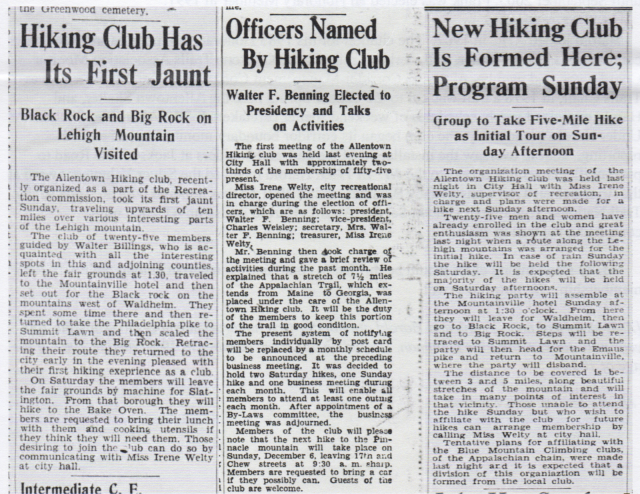

October 1, 2020
Who Was George W. Outerbridge
By Barbara Wiemann
Who Was George W. Outerbridge
By Barbara Wiemann
...and why is a shelter named after him?
George Whitney Outerbridge was the second person to hike the entire Appalachian Trail. George was born in Philadelphia on May 12, 1881, the only child of Alexander E. Outerbridge, Jr. and Mary Eli Whitney. His mother died seven days after his birth. His father had worked with Alexander Graham Bell to demonstrate the telephone at the Philadelphia Centennial Exposition in 1876.
Perhaps because his mother and maternal grandmother both died after childbirth, George chose to become a gynecologist. He graduated from Harvard University in 1905, received his M.D. from the University of Pennsylvania in 1907, served as Chief Gynecologist at the Methodist Hospital and Chief Surgeon at the Gynecean Institute, and taught at the University of Pennsylvania.
During World War I, he served in France with the Pennsylvania Hospital unit, he was in charge of a venereal disease clinic. After the war, George left academic medicine and concentrated on his gynecological practice. He never married.
George was a charter member and a club leader of the Philadelphia Trail Club, which was organized in 1931. His first AT hike was Oct. 30, 1932, from Lehigh Gap to Bake Oven Knob. Joined by Martin and Mildred Kilpatrick (also PTC leaders), George section hiked the entire trail, completing his journey at Damascus, VA on June 22, 1939. An account of his adventures was included in volume 1 of Hiking the Appalachian Trail, ed. by James Hare (Rod ale Press, 1975).
In 1960 the Philadelphia Trail Club added the maintenance responsibility for the 5 miles of the AT between Lehigh Gap and Lehigh Furnace Gap (the club was already maintaining 21 miles of the AT between Wind Gap and Lehigh Gap). In 1965, when the club constructed a shelter near a never-fail spring on this section where George began his AT hike, they named it for him to recognize his club leadership and commitment to the AT.
George died on Jan. 16, 1967, age 85.

August 17, 2020
Guidance in the COVID-19 Era
From Mike Passo, Executive Director of American Trails
Guidance in the COVID-19 Era
From Mike Passo, Executive Director of American Trails
Whether hiking, bicycling, riding on horseback or participating in motorized recreation nearly everyone uses trails for a similar goal - to spend time outdoors. This time outside, whether a short walk down a paved trail to work in an urban setting, or a high to appoint reachable to only a few Americans makes trail users happier people. We all know that spending time outdoors could improve our personal health in many ways like less than anxiety, decreasing depression, first and creativity, and increasing optimism.
But during this time of crisis, not all recreation is responsible.
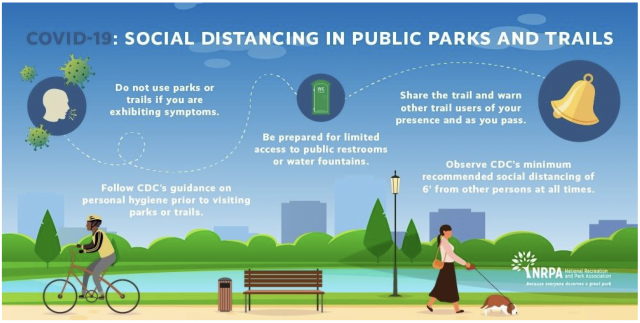
- Do I have the potential to come within 6 feet of people who are not part of my household? Is the trail wide enough, or does it offer the opportunity to get me in my equipment at least 6 feet (many experts are now saying 12 feet) away from another person passing on the trail. Single direction (one-way) trails are the best option for allowing limited exposure to other people.
- Does this activity put me at risk for potential rescue straining local resources? Now is not the time to be attempting highly challenging or dangerous activities or highly technical trails that have a higher likelihood of you hurting yourself. Our hospitals have enough to worry about now, without you feeling out there waiting rooms with broken arms or twisted ankles.
- Am I coming into contact with surfaces that can hold and transfer the virus? Avoid being out long enough that you would need to use the trail head facilities (toilets), we need to tie up your horse at a crowded hitching post.
- Will this put me in closer contact with vulnerable populations, such as those with compromised immune systems, persons over the age of 65, or those who are pregnant? Your actions do not only affect you, but have a great effect on the people around you. Any time you move during this pandemic, you have the potential of carrying the virus with you as an asymptomatic carrier, or even on your clothing. No matter what, avoid even remote contact with vulnerable populations.
- Do I need to travel outside of my local community to do this? If you travel far to get to your trail or outdoor recreation experience, you may need to stop stop for gas or pick up food at a restaurant. Stay close to home to limit these exposures.
If you can answer yes to any of these questions please alter your plans to keep your community safe by finding another form of recreation, a different location, or staying home.

January 16, 2020
Things Change - But Not Our Love of the Outdoors
by Karen Gradel
Things Change - But Not Our Love of the Outdoors
by Karen Gradel
For a while now Barbara Wiemann has been organizing and digitizing the Club’s archives. I was interested in seeing how the club has changed over the years, so I took the 1st box that covered 1931 to 1943 home.
The box is filled with meeting minutes, pictures, membership lists, newspaper articles and more. I started reading the first minutes and found that the first meeting was held Wednesday, Dec 2nd 1931 at Allentown City Hall. At that meeting the first officers were elected and the members picked the name as Allentown Hiking Club and set the fee to join the club at $1.00. They decided on a schedule of 2 Saturday hikes, one Sunday hike and a business meeting every month. The club’s first hike was Dec 6th to the Pinnacle. They were informed they were responsible for maintaining of the Appalachian Trail from New Tripoli-Tamaqua Rd seven and a half miles west to Tri County Corner.
A big difference is how the hikes were scheduled. There was a Program committee comprised of 3 members that would create a hike schedule for the next 3 months. The upcoming hikes were announced at the meeting and ‘sketches and descriptions were distributed to the members.’ If there was a change in the schedule a postcard would be sent to each member detailing the change.
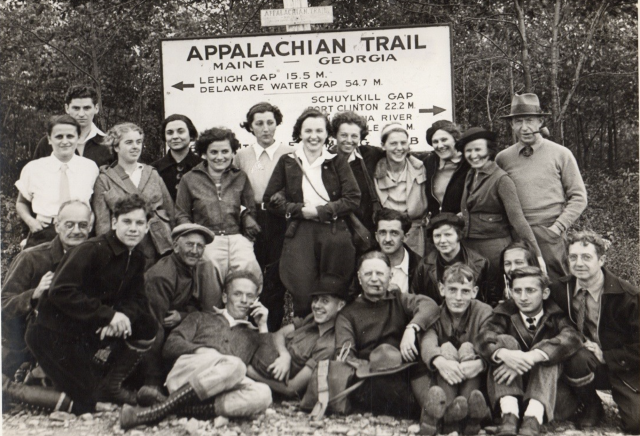
Photo from a hike on October 11, 1936
While reading through the minutes of the first few year’s meetings, one of the most frequent subjects for discussion was transportation. We take for granted how easy it is to get to a hike. We just get in our cars and go but back then not everyone had a car. At the January 1932 meeting it was voted that everyone on a hike give 10 cents to the treasurer for a gasoline fund. In August 1932 the club decided to hire a truck and driver who would transport hikers a distance of fifty-seven miles for $5.50. At the August 1933 meeting a motion was approved to put out a box at each hike that required a car and every one could put in what they can and then it would be divided evenly among the drivers. And in September 1934 it was agreed that the cost of transportation to the hike would be determined during the planning and be announced with each hike.
While there was a lot different there were also some things that were the same. The most obvious is our love of the outdoors. One of the other similarities is the effort to recruit new members. Today one of our main sources is Social Media but back then it was more of a word of mouth approach. At the January 1938 meeting when it was announced there were 62 members the President urged members to ‘try to interest other people and to make our club sound so interesting that other people would think it is a privilege to join.’ And in January 1939 the Club President suggested everyone bring a non-member friend to the next hike to encourage new membership. Both are also good ideas for today.

January 16, 2020
New Arrival Dates for Newsletters
by Susan Meyer
New Arrival Dates for Newsletters
by Susan Meyer
A decision was made at the December meeting to change the delivery and planning months for the newsletter.
For this year only the Summer newsletter will consist of four months: April, May, June and July. Hike leaders please take this into consideration while planning your upcoming events.
- Summer Newsletter will be delivered in April 2020
- Fall Newsletter will be delivered in August 2020
- Winter Newsletter will be delivered in November 2020
- Spring Newsletter will be delivered in February 2021
Thank you for your time and flexibility.

January 16, 2020
A Hike from the Past
A Hike from the Past
Jan. 5th., 1936 at the break of day, 18 daring pedestrians arose, packed their knapsacks with rations and reported at 7th. & Hamilton Sts. at 8:00 am to survey the hills, valley and wild life of Lowhill Township.
Twenty-three had registered for the first ramble of 1936 but ten failed to answer the roll call. Five hikers not on the list joined the robust bunch. The sky was overcast with heavy clouds, ceiling low and a cold gale from the North; not very inviting for an all day trek.
E.J. Schantz headed and Mr. John Leiby, first aide-de-camp was pathfinder and custodian of charts, maps, compass, pedometer, thermometer and the first aid kit. Messirs. Barnes, Danner, Maier and Santa Maria transported the company to Schnecksville where the cars were parked at the Buffalo Inn. Now we headed into the Trexler Game Preserve with rapid tread and collars up; the wind being stronger than in Allentown. The roads were icy and the field covered with snow, we arrived at the U.C.C. Camp and had a stroll around the dormitories and the mess hall. After a short pause, we continued on our march and found the less traveled roads had more ice, and we had to be more careful. Almost everyone expereinced [sp] some comic performance to retain a perpendicular position and about one-third of the party had a real flop including the leader. The streams were swollen much above normal and carried large pieces of ice.
At near 12 Noon, the weather changed. The clouds disappeared, the sun shone bright and calm and cheerful was the remainder of the day. We arrived at a cluster of beautiful Eastern Hemlocks at a steep incline on the banks of Mill Creek and here we tarried to cook and eat. Two of the party lost their grip on their thermos bottles which slipped into the stream below. One was recovered and the other continued with the swift current.
Our next visit was at one of Trexler's sheep ranches. Mr. Santa Maria took a group picture of the ladies each holding a lamb. Here we tested some rich cottage cheese made from sheep milk. The men in charge seemed glad to tell us about their flock and making cheese.
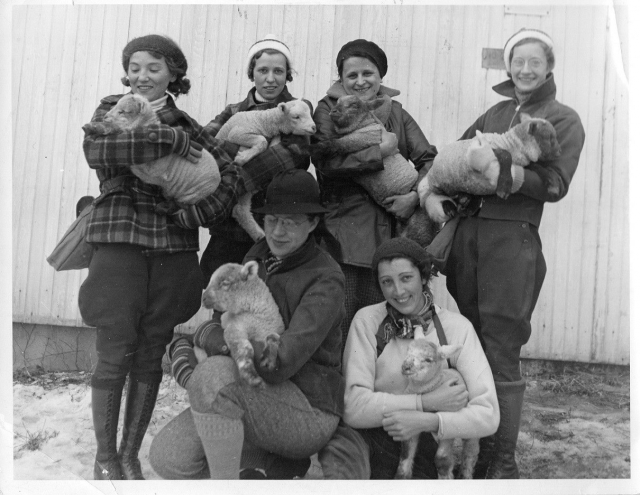
A few more miles and we beheld the ruins of a house and a pathetic little shack, the domicile of Mrs. Holben and her brood. Here law & order and law defiance clashed. Mr. Holben killed the late sheriff Mark Seuseubach and his deputy, Harry Siegfried with a shotgun. Later the home was burned where Holben had barricaded himself inside and he was killed by a shotgun blast.
We saw deer, pheasants, and rabbits but no elk or buffalo. it was sunset when we reached the autos and about six in the evening when we arrived home. We had tramped twenty miles on our all day outing.
The following were in the party: Misses Dorothy Hamstreet, Evelyn Newcomber, Jennie Hillaird, Helen Schaeffer, Clarissa Krommer, & Mrs. Homer Sleakel, Messers. John Leibv, Louis Bechtel, Sam Vivian, Kenneth Yocum, Henry Shields, Les Maier, H. Diehl, Sam Hillaird, Harold Barnes, Jacob Santa Maria, Mr. Danner and E. J. Schantz.
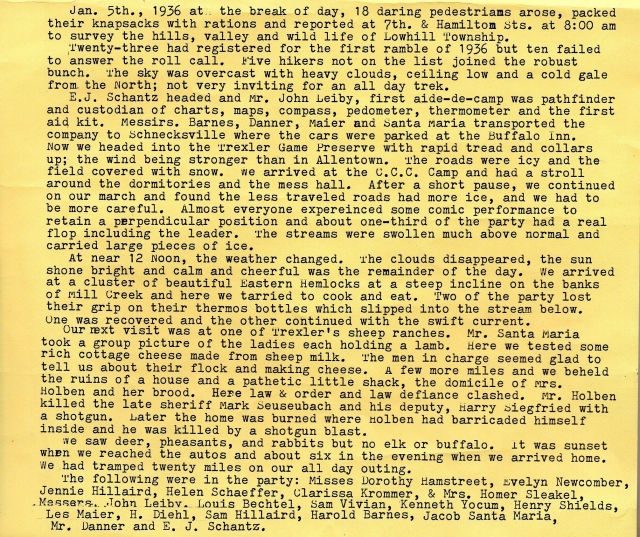

January 16, 2020
More Trail Magic
More Trail Magic
On a cold and rainy Sunday in October a group of Club members took coffee and snacks to the Trail Crew who are working on the relocation of the trail from Ashfield Rd to Lehigh Gap. They had been working on the section for 6 weeks and completed one mile of trail. The crew came from all over, including West Virginia, Michigan and Maryland.
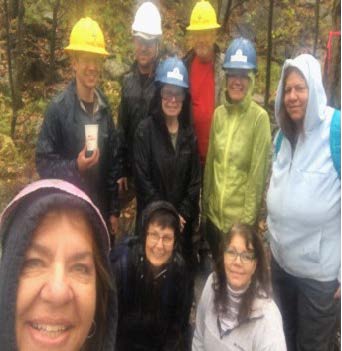
The Crew and Club selfie
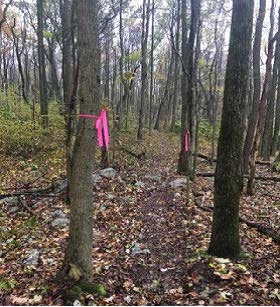
New Trail Section
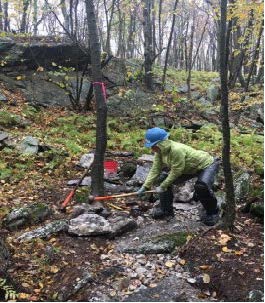
They break and create all the rock on site.
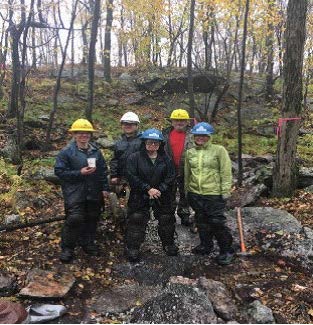
The Crew

September 29, 2019
Fall Is Here
by Karen Gradel
Fall Is Here
by Karen Gradel
Fall priorities include reporting your AT volunteer hours, learning about charcoal hearths on Blue Mountain, and attending our end of year events.
Summer is over and our trail maintainers have spent many hours clearing blowdowns, blazing, getting rid of invasive plants to keep the path clear. For all those who have helped with the maintenance thank you and don’t forget to get your volunteer hours into Ed Ritter by Oct 9th. Also anyone else who has helped with corridor monitoring , leadership, administration, websites, newsletters, finance, etc. should submit hours too. Things not to report are participating in (as opposed to leading) recreational A.T. hikes, planning or attending social events, such as dinners and picnics, feeding hikers, a.k.a. ‘Trail magic’ or trail maintenance on trails other than the AT. Why is it important to report all of our hours? ATC uses the hours of all the volunteers to obtain NPS funding.
It is also the time of year we do Corridor Monitoring. If you are interested in helping with the monitoring or just want to go along and find out what is involved, keep your eye on the forum or contact Lucy Cantwell.
A ‘don’t miss’ is the October presentation by Muhlenberg college Professor Benjamin Carter who will give a talk on his research of the charcoal hearths located on the Blue Mountain. There will also be a hike on October 5th to accompany his presentation and give us a ‘first hand’ look at the charcoal pits. Coming up we also have our holiday pot luck on December 4th, our holiday hikes and our annual New Year’s Eve hike to the Allentown Shelter that has been a tradition since 1976.

September 29, 2019
Trail Magic Events
Trail Magic Events
Photos from our annual effort to ease the burden of thru hikers as they make their way to Maine and Georgia.
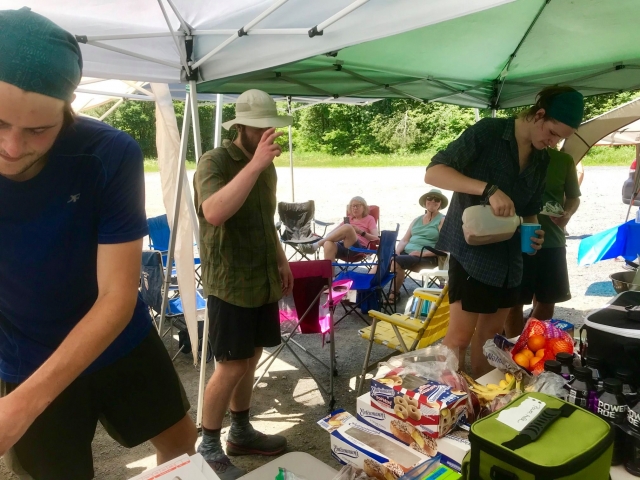
The chocolate milk was a hit.
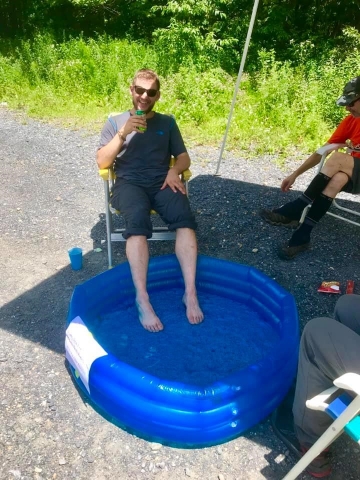
A pool to cool tired feet.
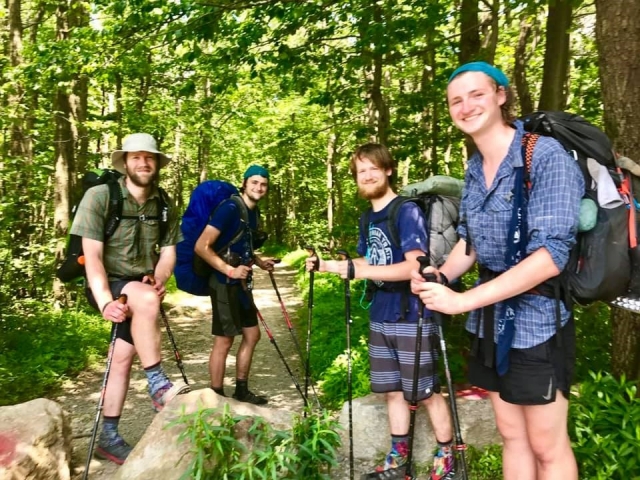
Four happy hikers head back to the trail.
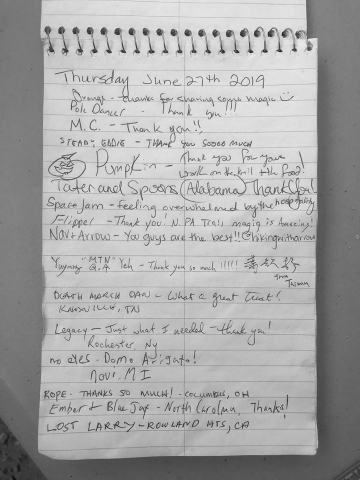
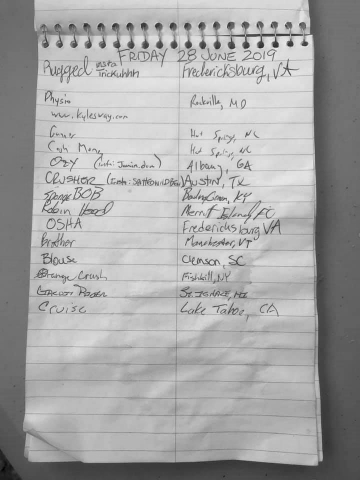
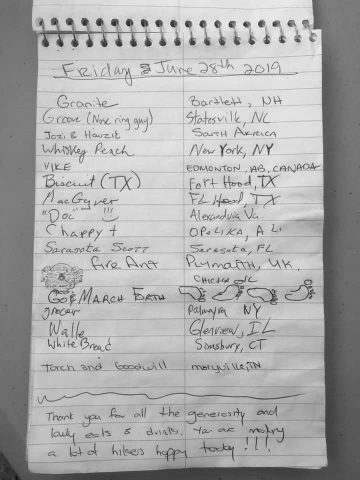

September 29, 2019
Second Section Hike on the Appalachian Trail
by Terri Stubits
Second Section Hike on the Appalachian Trail
by Terri Stubits
Our Massachusetts summer section hike.
Last year, we (Neil and I, Tom, Patti, and their son Trip) did our first section hike on the Appalachian Trial in Virginia and decided to do another section hike this year. Tom and Trip have completed the AT in VA, WV, MD, PA, NJ, NY, and CT. They have completed about half of MA, and this is where we decided to section hike. Patti plans all the logistics, and I made reservations at the Berkshire Lakeside Lodge in Becket, MA for our first night after driving up. This lodge is 0.1 distance from the trail. The lodge also let us leave our vehicle there while we hiked. Our plan was to hike (Tues – Fri) from the lodge to Cheshire, MA, a distance of 28.3 miles. Shuttle back from Cheshire.
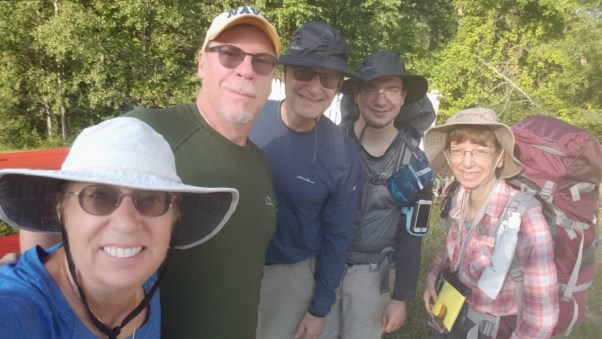
Left to Right – Terri, Neil, Tom, Trip and Patti
Tuesday morning we started out with a 780 foot climb up Becket Mountain, and continued to the October Mountain Shelter (7.2 miles). Because there was not a reliable water source near the shelter, we stopped 2 miles prior and filtered water and carried extra water to the shelter. The water looked like weak tea even after going through the filter, so I added tablets just in case. This tea tinted water tasted great! Really, it was delicious. Carrying the extra water weight for 2 miles was killer and Neil carried most of it for me. We arrived about 3 pm, and picked out a campsite. It immediately started pouring rain as soon as we got our tents up! Pounding rain for about 1 ½ hours, with water pooling around our tents. As the rain was stopping, we heard a loud thunk! A thick dead branch came down right between our tents. We made dinner (had mini bottles of wine a neighbor had given me, which Tom carried), wiped some of the mud off our tents, and got our bear bags ready for storing. This shelter has a bear box which is really nice. Downside was the mosquitos. Patti and I got bit the most, even after using bug repellent.
It didn’t rain any more that night so our tents had a chance to dry out. Wednesday morning, while eating breakfast, we checked the weather for the Kay Wood Shelter (8.8 miles) and the forecast was for severe thunderstorms and heavy rain that day and into the night. We made a quick decision to hike 12 miles into Dalton, MA. Called for availability at the Econo Lodge in Dalton and made reservations. Now we just hoped we’d get to town before getting caught in the downpour. All day there was thunder but no rain. We stopped for lunch as well as several quick breaks. Tom brought Pellegrino which is very refreshing on the trail. Trip was out front setting a good pace, but I was struggling with all the ups and downs on the trail. Tom turned on his Bluetooth and started playing music. First song was “99 Luftballons” and it really helped me to keep going. I drank most of my 2 ½ liters of water and we stopped before getting to town to filter more water.
We walked to Angelina’s Submarine Shop with cheesesteak bombs on our minds. It was about 5 pm and again just as we got there it started to rain. We left our packs out front under the picnic table umbrellas and went inside to order. These cheesesteaks are loaded with meat, nice and hot, so good. I took out my phone and ordered an Uber to take Neil and I back to Becket to pick up our truck. By the time the Uber delivered us to the Berkshire Lakeside Lodge, the rain had turned torrential with white bright lightening and booming thunder. Neil and I drove back to Angelina’s to pick up Tom, Patti and Trip and drove to the Econo Lodge. Yah! We get to shower and sleep in a bed. Next morning all of us limped into breakfast (except Trip, he was good to go). It was still raining, and we decided to pack it in. We drove home a little short of our goal, but undeterred. We’re already planning next year’s section hike! Terri Stubits P.S. I caught a cold.

September 8, 2019
A Chance Encounter with Trail Maintainers in Maine
By Hal Wright
A Chance Encounter with Trail Maintainers in Maine
By Hal Wright
The man carrying a chainsaw to Little Bigelow Lean-to stuck out his hand and introduced himself: “Hi, I’m Hawk Methany.” My canine companion Sofia and I would stay at the lean-to that night, waiting out a thunderstorm which threatened to bring hale and high winds, on the third night of a six-day section hike.
I knew of Hawk, the ATC’s North Atlantic Regional Director, and joked that I was pleased to greet someone who is “AT famous.” Hawk was soon joined by Maine Appalachian Trail Conference Board Member Tom Carr, and ATC employees Paige Gregory and Dan Hale. Tom also serves as the MATC’s Hazard Tree Coordinator.
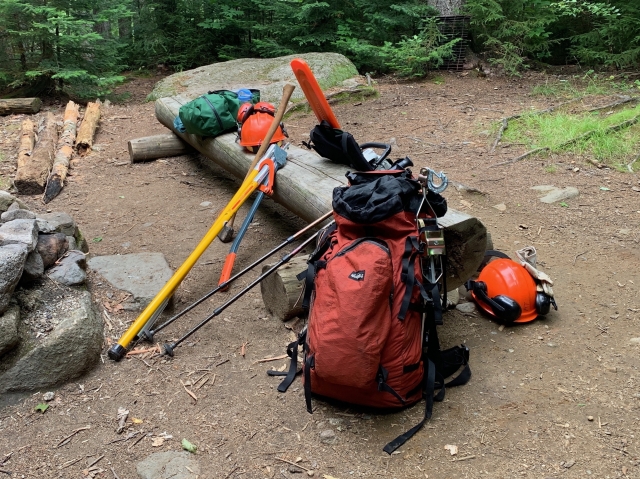
Everyone carried heavy tree-cutting equipment in and on top of backpacks. Their task was to cut down six hazardous trees which might fall, posing a risk to tent campers in the area of the shelter. Identifying the trees and cutting them down, using saws and tensioned ropes, took almost four hours of work.

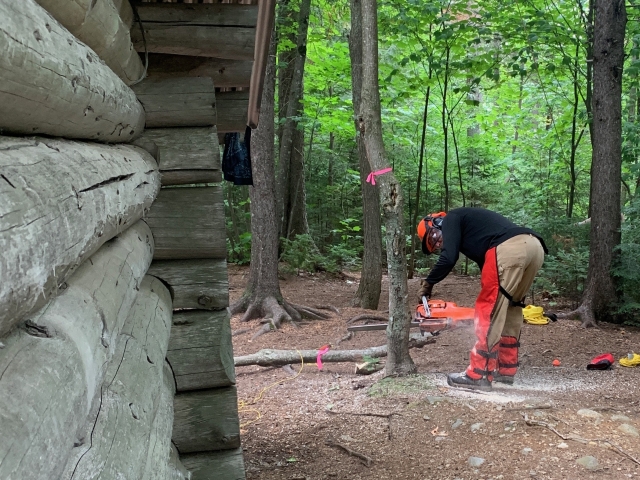
By the time the work was done, it had started to rain. The four packed up, said goodbye, and started the 1.5 mile journey back to the trailhead.

From left: Dan Hale, Paige Gregory, Tom Carr, Hawk Methany
As one thru hiker put it, “Maine is a giant stone with trees trying to grow on it.” Geology dictates the character of the Maine AT, creating streams to ford and random tangles of rocks, roots, and mud. But the hiker also encounters hundreds of bog bridges, and elegant flights of stairs made from nearby stones. As members of Allentown Hiking Club know, these and many other accommodations are the work of AT trail maintainers and builders, most of them volunteers from clubs along the trail.
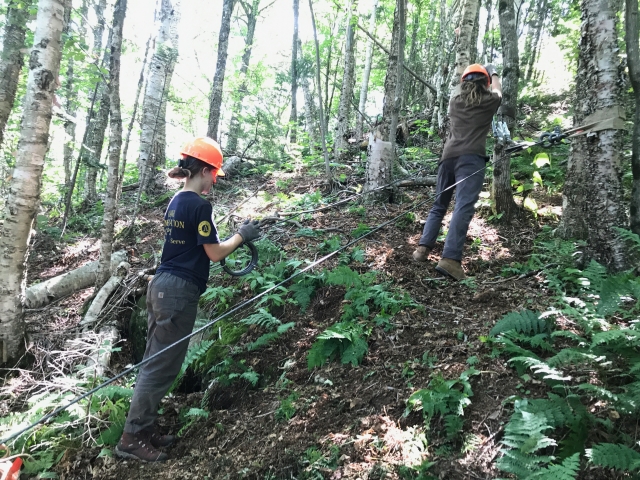
Moody Mountain, Maine. Maintainers rig a come-along and cables to position stone steps.
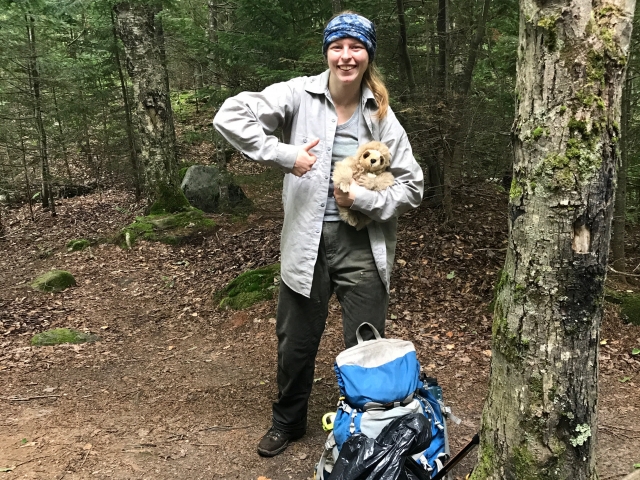
Bree is an Appalachian Mountain Club employee who tends to the campsites in New Hampshire and southern Maine.

September 8, 2019
One To Go!
By Hal Wright
One To Go!
By Hal Wright
The author, AHC's webmaster since 2002, has pursued a 21-year quest to hike the Appalachian Trail in sections.
When I walked past the Rattle River Hostel and on to the trailhead in Shelbourne, NH, I had finished 13 of the 14 Appalachian Trail states.
This summer's hikes comprised some of the most demanding and rewarding sections of the Appalachian Trail so far. The southern Maine mountains and Mahoosuc Notch lived up to their reputations as the toughest obstacles anywhere on the AT. I remain awestruck as I reflect on the rugged natural beauty of the trail environment in Maine, and will never forget seeing a bald eagle catch a fish in Kennebec River as a waited for my turn to be ferried across the river. I also had the pleasure of meeting many of the hard-working folks who keep the trail in great shape year after year for hikers like me to enjoy.
With this summer's hikes behind me, I'm about 210 miles from my goal of finishing the Appalachian Trail in sections. I thank all those who maintain the trail and help hikers along the way.
The details: Two section hikes, (1) South Arm Road near Andover ME, to Shelbourne, near Gorham NH, and (2) ME Route 27 to ME Route 201, Caratunk. Miles traveled since 1998: 1979. Miles to finish: 210.
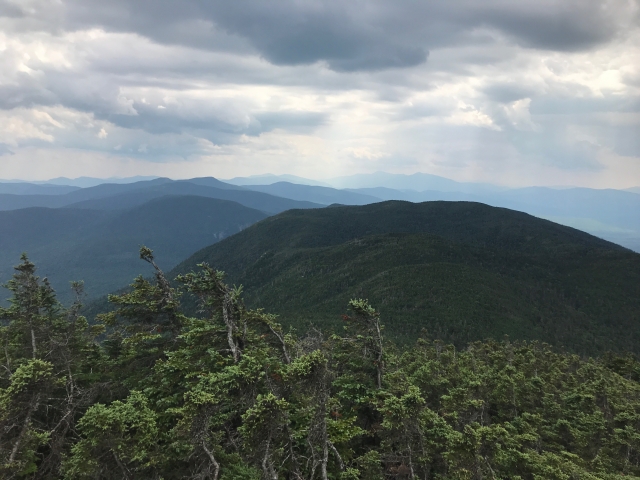
Looking Southbound into Grafton Notch State Park and toward Mount Washington.
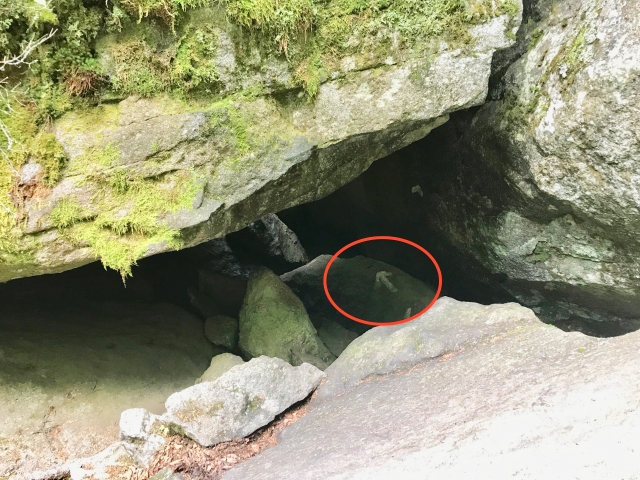
The trail in Mohoosuc Notch includes numerous passages through caverns. This one-mile section can take hours to traverse.
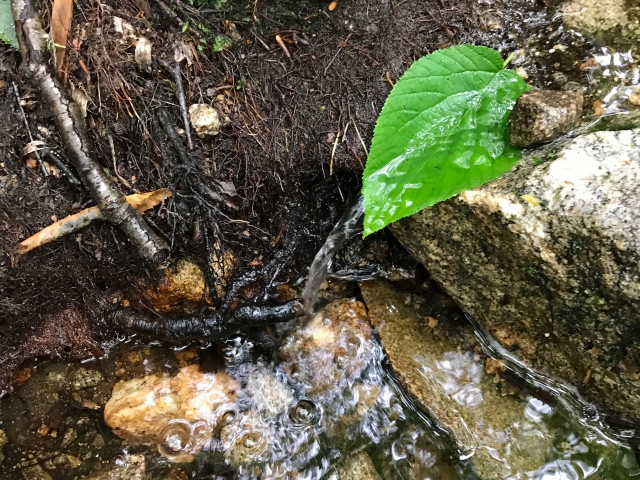
A leaf is all that's needed to quickly fill one's water bottle from a mere trickle of spring water.

A respite for the weary at Sand Beach, East Carry Pond.
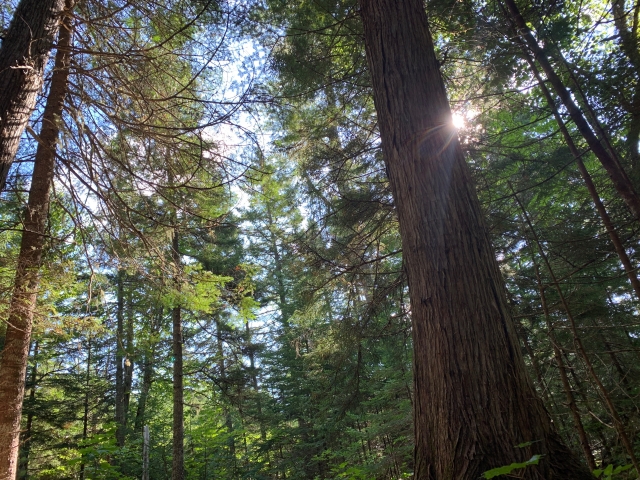
The afternoon sun peaks through a stand of Maine cedars.
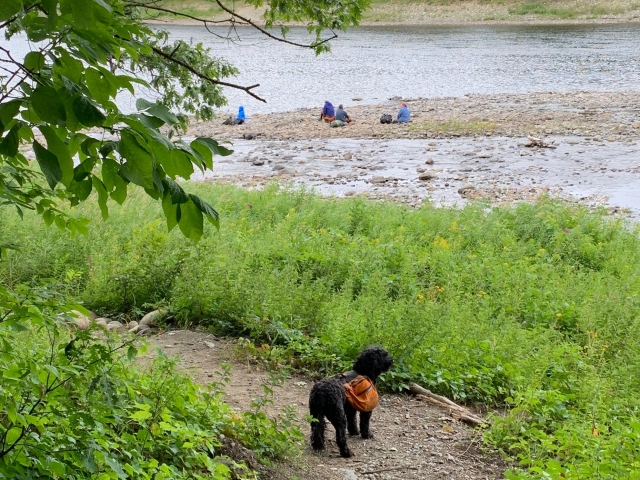
Sofia discovers the Kennebec River and hikers waiting for the first canoe ferry rides of the day.

The Kennebec River ferry arrives!

July 17, 2019
Hiker Safety
By Karen Gradel
Hiker Safety
By Karen Gradel
We hike for a variety of reasons, for physical fitness, to challenge themselves, to explore nature. We pack our backpacks and head out never thinking that we won’t get from point A to point B without a problem.
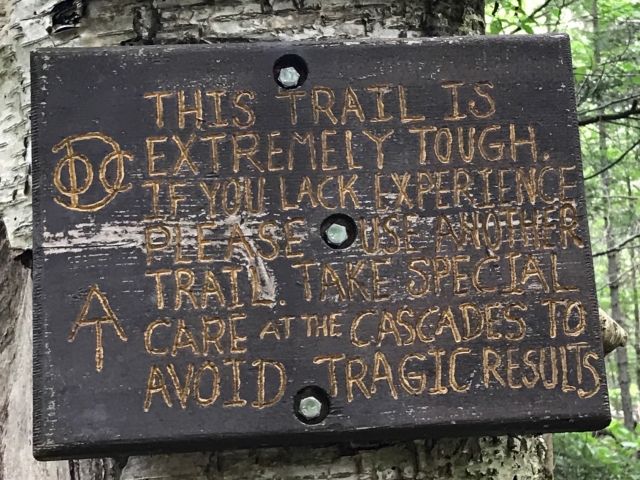
In May a Berks county woman walking her dog got lost on the on the Tom Lowe Trail. I’m sure she thought she was just going for a short hike since she didn’t have any food or water with her. The idea she would spend the night hunkered down outside never crossed her mind. This should be a lesson for us to not get too comfortable even on a short or familiar trail.
Having a fully charged cell phone with you to call for help is basic item to carry with you but there are dead spots on the trail with no cell service so make sure you tell someone where you will be and what time you will be back. And check in with that person when you return. Always take water with you and for longer hikes a protein bar, water filter and thermal blanket should be in your pack. You should carry a first aid kit and make sure you keep it updated and replenished as you use items from it. And a tip from Michelle Hinkle is to carry your old expired Driver’s License in your backpack for identification.
If possible hike with a companion, there is safety in numbers. While the trail is usually a tranquil place where there is a real comradery among the ‘trail family’ sometimes the violence from the outside world creeps in. One such incident happened in May 2019 when one hiker was murdered and another in-jured by an unstable person. Even though the group of four hikers made the decision to leave the area where the unstable person was, two of the hikers were still overpowered. If you find yourself in a situation where you feel uncomfortable get out of the area as soon as you can. And make sure you report anything unusual to the local authorities. The Appalachian Trail Conservancy says ‘If you see something, say something’. The Nation Park Service has a 24 hour Dispatch/Communications Center which can be reached at 1-866-677-6677 or you can send an email to incident@appalachiantrail.org. If you are doing trail work or hiking in our area and see something that doesn’t seem right our local Game Warden Tyler Kreider has asked that we let him know about it. The Pennsylvania Game Commission violation number is 1-888-PCG-8001 or you can reach Tyler at 610-926-3136. Safe Hiking.

July 17, 2019
Ed Ritter Named Volunteer of the Year
Ed Ritter Named Volunteer of the Year
Ed Ritter, AHC’s Trails Chair, has been selected as the 2019 Volunteer of the Year by the Mid-Atlantic Regional Partnership Committee of the Appalachian Trail Conservancy.
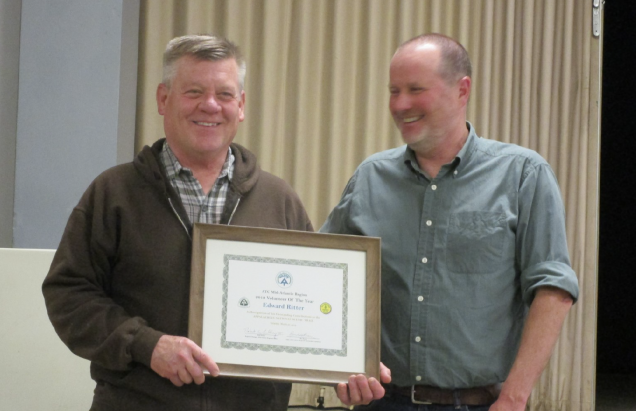
Ed’s contributions to the Appalachian Trail spanned 30 years. In 1989, Ed and Frank Bertalan were appointed AHC Trails Co-chairs. Since 1992, when Frank became the AHC Monitor Chair, Ed has served as Trails Chair.
During these 30 years, Ed has organized Appalachian Trail work trips, supervised trail relocations, scheduled shelter caretakers, and performed thousands of hours of trail maintenance. The club built a privy and constructed a new shelter during his tenure. Ed is a certified sawyer, and handles blow down removal. He has participated in AHC’s trail assessments, the trail inventory for APPA, and submits the club’s hours report to ATC each year. Ed has worked with Scouts (such as projects to earn Gold Awards) and led a special work trip for Girl Scouts in conjunction with their 100th Anniversary Celebration. Ed compiled the club’s Local Management Plans. In addition, Ed was a club corridor monitor for two areas for more than 25 years.
Edward Ritter is the consummate club volunteer. For 30 years, he has been the guiding force in maintaining and improving the Allentown Hiking Club’s Appalachian Trail section of trail, and is very deserving of this honor. Congratulations and thank you to Ed!

July 17, 2019
Help Wanted: AT Corridor Monitors
By Lucy Cantwell, Corridor Monitor Coordinator
Help Wanted: AT Corridor Monitors
By Lucy Cantwell, Corridor Monitor Coordinator
We are seeking a few new persons to help with this very important task!
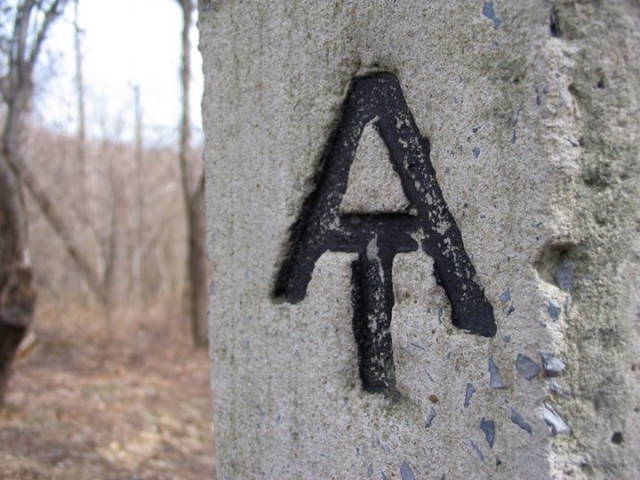
Each fall, the Allentown Hiking Club monitors the boundaries of our section of the AT, called the "corridor," which is land owned by the National Park Service that extends a few hundred feet on either side of the trail. Some of our long-time monitors, who have been performing this function for upwards of 20 years or more, are no longer able to commit to this duty.
According to the ATC Volunteer Leadership Handbook, Corridor Monitors "are responsible for visiting and reporting on the condition of an assigned area of corridor land within a Trail club’s section.... Volunteers interested in monitoring may be quite different from those who like trail work—good monitors often enjoy orienteering, bushwhacking, and traveling in rugged terrain."
The monitoring process is not unlike a scavenger hunt, with a compass and a map to assist you. If ever you are in need of an adventurous hike, this is it. If you think you might be interested in participating in the corridor monitoring, please contact the AT Monitor Coordinators listed on page 2 of the newsletter. We'll teach you how to collect the required information by pairing you with an experienced monitor assessing his/her section of the trail. The commitment on your part, after this simple training, is basically one day a year, scheduled by you at your convenience. Be adventurous! Volunteer and see what it's all about!
For an excellent description of the duties of a corridor monitor, please see this article on corridor monitoring published in the Spring 2019.

May 10, 2019
Spring Is Here, Invasive Species are Starting to Sprout
By Karen Gradel
Spring Is Here, Invasive Species are Starting to Sprout
By Karen Gradel
Spring is here, the air is warming up, the birds are chirping and the plants are starting to sprout. But not all the plants emerging along the trail are a good sight. We have invasive plants along our section of the Appalachian Trail.
So what exactly is an invasive species? Not every plant that is introduced to a new region is invasive. Orange and Banana trees are not native to the US but after being brought here they are not invasive. According to Executive Order 13112 in 1999 a species is considered to be invasive if it meets two criteria: (1) it is nonnative to the ecosystem under consideration, and (2) its introduction causes, or is likely to cause, economic or environmental harm or harm to human health.
AHC has been concentrating mainly on two invasive species, Garlic Mustard and Japanese Stilt Grass during it’s Trail Maintenance. Both choke out local species and can create dense populations in as short 5 year period. They can eliminate the rare plants living in our section of the trail, such as the Pink Lady Slipper that can been found in Spring along the trail near Fort Franklin Road. Garlic Mustard also impacts the West Virginia White Butterfly. The butterfly mistakes Garlic Mustard for it’s host plant and the offspring laid on it don’t survive. Removing the plants at the right time is also important because both Japanese Stilt Grass and Garlic Mustard seeds can remain viable in the ground for five or more years.
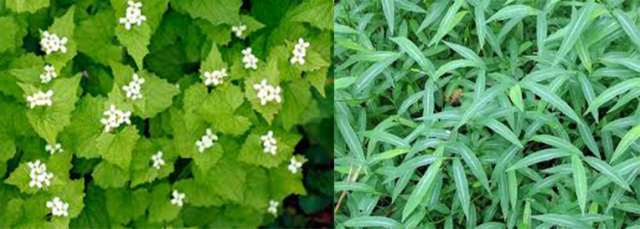
Garlic Mustard (left), Japanese Stilt Grass (right)
We have two maintenance hikes scheduled this quarter. One on April 13th at Lock 2 and the other on May 19th on the AT, where we will be continuing our battle with Garlic Mustard and other invasives. Don’t forget to take some Garlic Mustard home with you, because it’s edible. Check out this recipe for Garlic Mustard Pesto:
Garlic Mustard Pesto
Tip: Garlic Mustard is different from other greens in that the more mature plant leaves are less bitter than the young leaves, so try to use leaves from 2nd year plants of this Biennial.
Ingredients:
11 cups lightly packed garlic mustard leaves and tips, loosely chopped
1/4 cup pine nuts
1 garlic clove
1/3 cup grated parmesan cheese
1 cup extra virgin olive oil
1/2 teaspoon salt
1/2 teaspoon sugar
2 squeezes lemon juice
Directions:
In a blender, grind the garlic, pine nuts and parmesan. Add the garlic mustard. While blending, pour in a steady stream of the olive oil for 1 minutes, or until smooth. Add salt, sugar, lemon juice and pulse until mixed.
Also don’t forget to check out the revised AHC website. There’s easier navigation to documents. The calendar is improved with more functions and a quicker way to view past hikes. Thanks to Web Master Hal Wright for all the work he’s done updating our website to make it more functional and easier to explore all of our upcoming events.

February 19, 2019
The Start of a New Year
by Karen Gradel
The Start of a New Year
by Karen Gradel
We look forward to many activities in 2019, as we say goodbye to some old friends and welcome new ones.
As we were honoring Holly Vogler with an Honorary Membership for her longtime service to the club, I looked around the room and saw a number of dedicated people who have served the club for many years. These people are the backbone of the AHC. This year and in the past few years we have seen the passing of some members who have been fundamental to the function of the club. We’ve been fortunate to have new members step up to fill these open positions in the club. We also have some new hike leaders this year. I want to sincerely thank everyone who has given their time to help the AHC preserve the physical trail and the spiritual ideals of the Appalachian Trail.
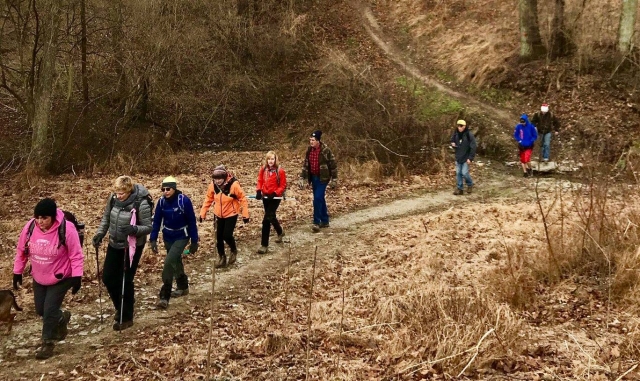
This upcoming year we have numerous opportunities for you to get involved. As always we have our Maintenance Events on the Appalachian Trail, at the Lehigh Gap Nature Center and at Lock # 2 on the D & L Trail. There will also be lots of hikes, some old favorites that are scheduled year after year and some new trails to explore. We are also going to add more family hikes to our schedule to get kids out into nature and excited about outdoor activities. Kayaking and camping trips will be offered. We will also provide Trail Magic again on June 27th and 28th. It’s always a good time to sit with the Thru Hikers and hear their stories. And one of the things we always hear is how well maintained our Shelters and section of the trial are. This is a testament to our hard working volunteers!
Have a great New Year of hiking,
Karen Gradel
AHC President
AHC President

February 19, 2019
Corridor Monitoring - What It Is and Why We Do It
by Lucy Cantwell
Corridor Monitoring - What It Is and Why We Do It
by Lucy Cantwell
Walking the boundaries of Appalachian Trail lands to prevent encroachments is an essential part of our responsibilities as a maintaining club.
It's the time of year for the Allentown Hiking Club to do our annual corridor monitoring. We talk about it a each meeting, but some of you may wonder, "What is this all about?" Here is a brief explanation of this annual activity.
A critical component of our duties as a maintaining club of the AT is corridor monitoring and boundary maintenance: keeping a close eye on the federal estate purchased to protect the Appalachian Trail. The AT "corridor" is the land owned by the National Park Service that extends a few hundred feet on either side of the trail. Corridor monitoring means walking along and examining the border of this NPS land and the adjacent lands ( for example, privately owned lands, state game lands, municipalities) to assure that all boundary markers are in place and no encroachments have occurred. This involves leaving the AT treadway and bushwhacking over rocks and through dense vegetation to locate "monuments," i.e., the markers installed by surveyors years ago to establish a line between NPS lands and that of neighboring landowners.

Encroachments, such as illegal dumping of waste, timber theft, rock piles, discarded machinery, hunting blinds, or evidence of incompatible uses such as ATVs are also documented. These discoveries are subsequently reported to the ATC (Appalachian Trail Conservancy) and corrective action is taken, if needed. During the monitoring we also post signage along the boundary lines, indicating which areas belong to the NPS. Volunteer monitors thus become the “eyes and ears” of state and federal landowning agencies. Monitoring helps assure the American public that its investment is being cared for and protected.
The Allentown Hiking Club monitors 35 tracts containing over 600 acres, which has 106 surveyor's monuments and 15 1/3 miles of exterior boundary. This is divided into 7 sections and is monitored by club members who commit to individual segments of about 4-7 miles each. Some of our monitors have been doing their sections for upwards of 20 years!
New volunteers are always welcome and encouraged to step up and join the action! If you think you might be interested in participating in the corridor monitoring, please contact the Monitor Coordinators listed on page 2 of the newsletter. We'd be happy to have you join one of the established monitors when they hike their section to collect the monitoring information. Also, keep an eye out for announcements on the AHC Forum, as monitors may post their hikes on the spur-of-the-moment, since good weather conditions are generally better for this activity. Be adventurous and come and see what it's all about!

February 19, 2019
The ATC 2018 Biennial Conference
by Cynthia Paetow and Agnes Sablow
The ATC 2018 Biennial Conference
by Cynthia Paetow and Agnes Sablow
The Appalachian Trail Conservancy’s (ATC) written mission is “to preserve and manage the Appalachian Trail – ensuring that its vast natural beauty and priceless cultural heritage can be shared and enjoyed today, tomorrow, and for centuries to come.” We were excited to be a part of the ATC conference this year and to learn how much this organization does for the hiking community.
One of the things that stood out is the number of clubs, organizations, governments and individuals that work together for the benefit of the Appalachian Trail (AT). One of the AT’s core values is Cooperation. We had speakers from A.T. Communities, the AT Park Ranger, ATC Board members, Youth Representatives and so many more. There are a multitude of groups, organizations, governments and individuals working hard behind the scenes to maintain this trail that we all enjoy.
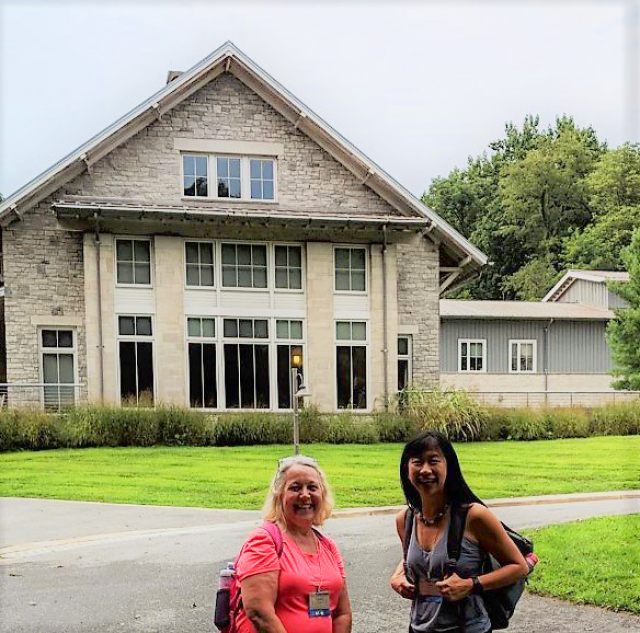
The focus for much of the weekend was on getting new people outside hiking on and maintaining our trails. Diversity in race, ethnicity, age and abilities was discussed and we were encouraged to look at our own groups and networks. Some ideas included offering specialty events such as those for young adults or family hikes to bring out adults and children together. History or cultural hikes were mentioned as well as reaching out to other diverse groups in our area.
Overall, we think our club is on the right track. Like many other clubs, we have an aging membership, but like any established group, it has its ebbs and flows. Our schedule is currently filled with many different kinds of activities from short city walks to long strenuous hikes, from kayaking to camping and a variety of cultural treks, maintenance hikes and social activities. We have daytime, evening and weekend hikes of various lengths. Our Meetup and Facebook pages have added to our Club Page, bringing in new attendees and members.
Our club can also utilize the ATC website. In fact, the ATC encourages us to list all our maintenance events on their website which is another way for people to find us. Logging all of our volunteer hours maintaining the AT is extremely important in continuing to obtain funding for the AT. The more hours that are logged and submitted shows the government how much work it takes to maintain the trail. The ATC can also “compete for a significant amount of NPS [National Park Service] funding from its national “Volunteer in the Parks” program.” So, when our Appalachian Trail Chair, Ed Ritter, asks us for our volunteer hours, please make sure he gets those.
Finally, we would encourage everyone to visit the ATC website. There is so much information there that we could not even begin to cover. Whether you are an active hiker, someone trying to get back into shape, someone who wants to help maintain the trail or someone who can no longer hike but wants to support the Appalachian Trail, there is something for everyone.
Hope to see you all soon on a hike, at a meeting or working together on a maintenance activity.

POSTS BY TYPE
POSTS BY TAG
POSTS BY MONTH